
2-Week Tour of Rome, Florence, Venice, & Italy's Scenic Countryside
 14 Day Tour of Rome, Florence and Venice
14 Day Tour of Rome, Florence and Venice
Overview
Trip Map
Itinerary
Inclusions
Reviews







14 Days 13 Nights
Best Time: Jan-Dec
Visiting Museums & Art Galleries
Exploring Scenic Countryside
Discover the glory of Italy on this two-week trip as you explore Rome's ancient ruins, the Renaissance glories of Florence, and the canals of Venice. The charm of the Italian countryside also awaits, as you'll travel through Tuscany's rolling hills to the towns of Siena and San Gimignano. This trip is made easy with a private airport pickup, guided tours with a local in Rome and Venice, and a half-day excursion with a private driver in Tuscany. You'll also enjoy detailed travel guidance at every step, ensuring that your adventure to Italy's most iconic attractions and off-the-beaten-path spots will be a dream come true.
- Gaze at the Sistine Chapel and the stunning architecture of St. Peter's Basilica in the Vatican City
- Feel history under your feet as you explore the Roman Forum and the Palatine Hill
- Sip Sangiovese in the Tuscan hills, as you visit UNESCO heritage sites brimming with life
- See the majestic Fountain of Neptune in Florence, a masterpiece adorning Piazza della Signoria
- Stroll around Piazza San Marco (St. Mark's Square) in Venice, the city of canals
- Get beyond the big cities on excursions to Siena, San Gimignano, and Verona
Discover the glory of Italy on this two-week trip as you explore Rome's ancient ruins, the Renaissance glories of Florence, and the canals of Venice. The charm of the Italian countryside also awaits, as you'll travel through Tuscany's rolling hills to the towns of Siena and San Gimignano. This trip is made easy with a private airport pickup, guided tours with a local in Rome and Venice, and a half-day excursion with a private driver in Tuscany. You'll also enjoy detailed travel guidance at every step, ensuring that your adventure to Italy's most iconic attractions and off-the-beaten-path spots will be a dream come true.
- Gaze at the Sistine Chapel and the stunning architecture of St. Peter's Basilica in the Vatican City
- Feel history under your feet as you explore the Roman Forum and the Palatine Hill
- Sip Sangiovese in the Tuscan hills, as you visit UNESCO heritage sites brimming with life
- See the majestic Fountain of Neptune in Florence, a masterpiece adorning Piazza della Signoria
- Stroll around Piazza San Marco (St. Mark's Square) in Venice, the city of canals
- Get beyond the big cities on excursions to Siena, San Gimignano, and Verona

Colosseum
Historic Landmarks

Vatican City
Churches & Monasteries

Piazza del Duomo
Churches & Monasteries

Uffizi Gallery
Museums & Galleries

Grand Canal
European History

Islands of Murano & Burano
Cultural
Must see sights

Colosseum
Historic Landmarks

Vatican City
Churches & Monasteries

Piazza del Duomo
Churches & Monasteries

Uffizi Gallery
Museums & Galleries

Grand Canal
European History

Islands of Murano & Burano
Cultural
Starting from
$3559
per person
 Not included
Not included Secure Your Customizable Trip
Enter your details to embark on a journey that can be tailored just for you.
Start
Travelers
0 travelers
Add Room
Remove Room
Preferred Hotel Stars
Select Hotel Stars
Craft Your Own Itinerary
Select your interests and destinations for a trip plan inspired by you.
Trip Map & Itinerary
Enable/Disable Map Scrolling
Click To Make Map Interactive

Trip Timeline
 Edit Details
Edit DetailsArrival
4 nights
Rome
Italy
Train: 2h
5 nights
Florence
Italy
Train: 2.5h
4 nights
Venice
Italy
Departure
Day-By-Day Itinerary
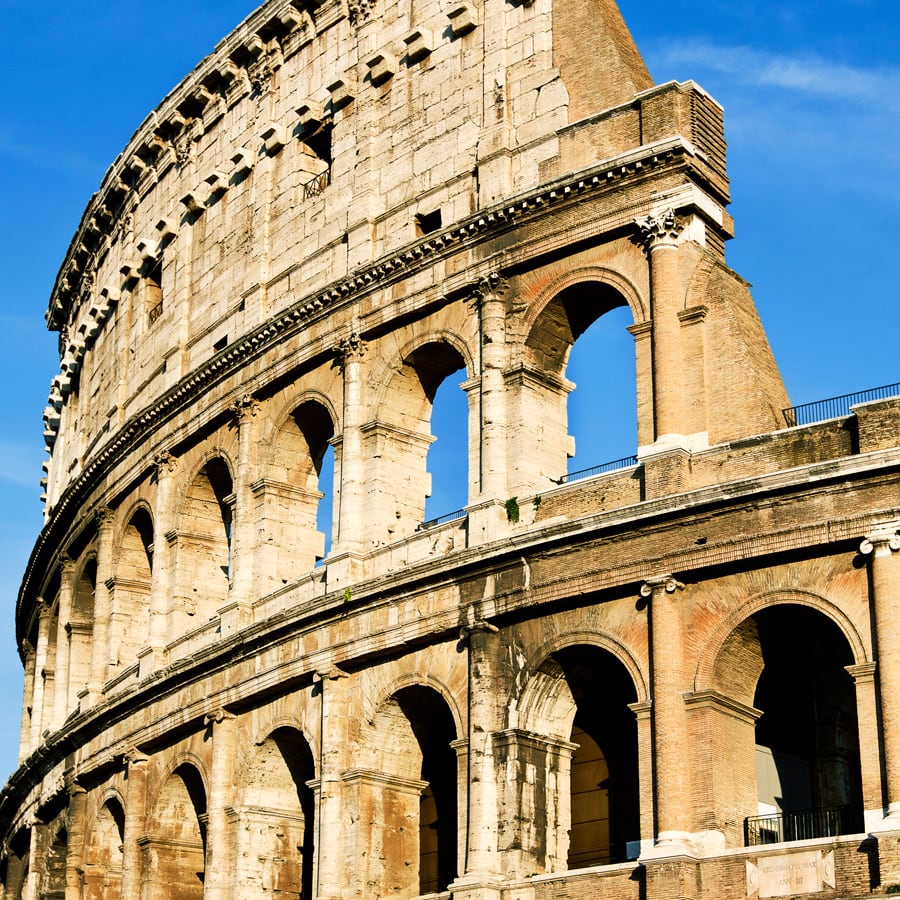
Day 1
Arrive Rome
View More
Day 1
Arrive Rome



To Be Determined
Private Transfer from Rome Fiumicino to Hotel
For your arrival in Rome, we will provide information on the customs and passport procedures. We will schedule a pick up for your flight's arrival time. You will be met at arrivals inside the terminal by a driver holding a sign with your name on it. The transfer is for your party only - you will not be sharing a vehicle. The cost of the ride will be included in your itinerary package and you will be taken directly to your hotel. IMPORTANT NOTE: Please be aware the car service can fit up to 1 checked item of luggage and 1 personal item per person, such as a purse or small backpack. If you think you will have more baggage, please inform your travel consultant as this may result in an additional fee.

Day 1
Arrive Rome
View More


Day 1
Arrive Rome




To Be Determined:
Private Transfer to your Hotel
Mid-Day/Afternoon:
Colosseum
Late Afternoon/Early Evening:
Forum (Ancient Rome)

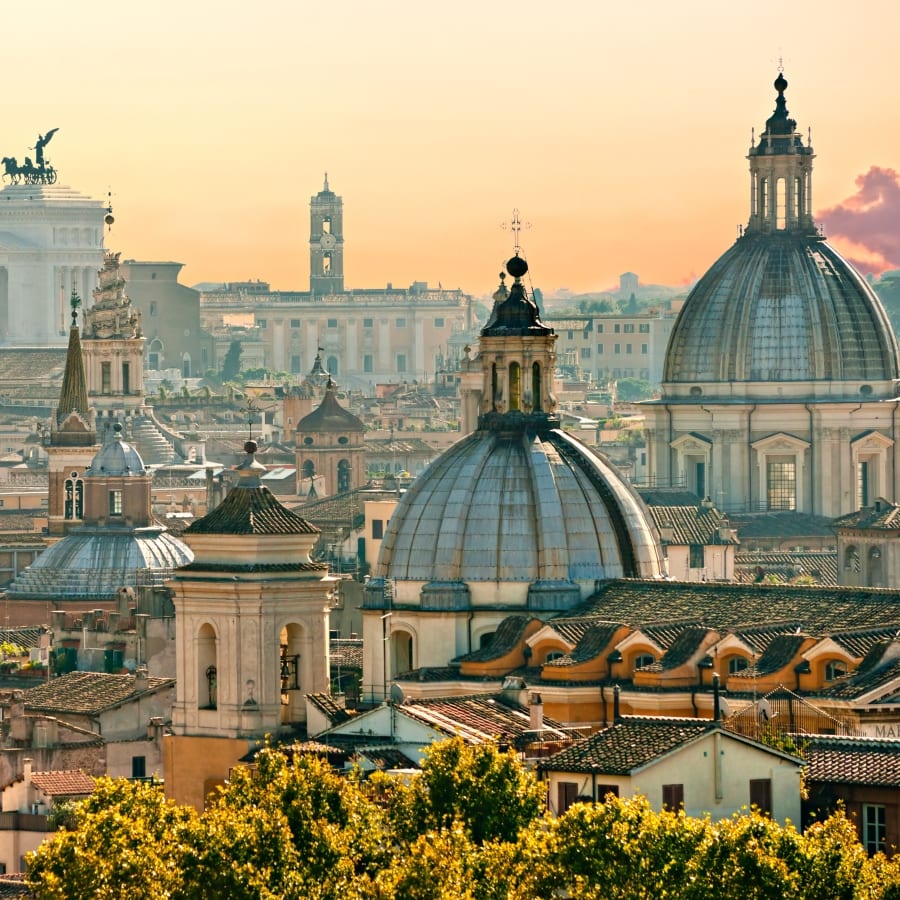
Day 2
Rome
View More
Day 2
Rome


9:00 AM - 12:00 PM
Grand Guided Walking Tour of the Historic Center
Get to know the historic core of Rome on this three hour private guided walking tour that takes in such famous sights as People's Square (Piazza Popolo), the Spanish Steps, Trevi Fountain where Anita Ekberg jumped into the water in Frederico Fellini's La Dolce Vita, the column of Marcus Aurelius, the Pantheon, and the most beautiful square in all of Italy - Piazza Navona.

Spanish Steps
Take a scenic walk up the 18th-century stairway where Audrey Hepburn and Gregory Peck set out on their Roman Holiday.
Show More

The Trevi Fountain
Admire one of the most iconic sights in Rome, made famous by Anita Ekberg in La Dolce Vita.
Show More

Pantheon
Visit this iconic former pagan temple converted into a Christian church.
Show More

Spanish Steps
Take a scenic walk up the 18th-century stairway where Audrey Hepburn and Gregory Peck set out on their Roman Holiday.
Show More

The Trevi Fountain
Admire one of the most iconic sights in Rome, made famous by Anita Ekberg in La Dolce Vita.
Show More

Pantheon
Visit this iconic former pagan temple converted into a Christian church.
Show More

Spanish Steps
Take a scenic walk up the 18th-century stairway where Audrey Hepburn and Gregory Peck set out on their Roman Holiday.
Show More
prev
next

Day 2
Rome
View More

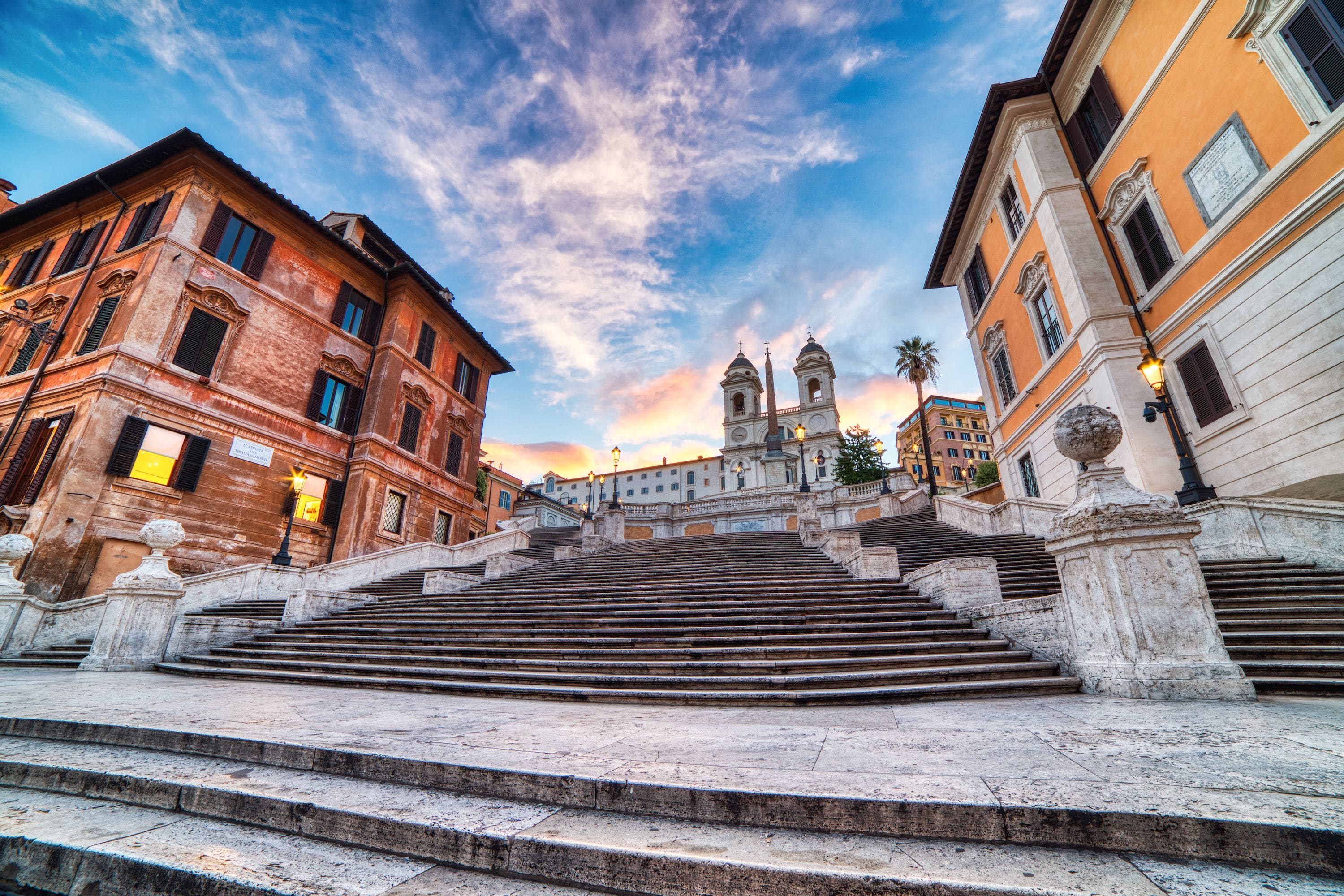
Spanish Steps
 Highlight of Grand Tour of Historic Center, Guided
Highlight of Grand Tour of Historic Center, GuidedTake a scenic walk up the 18th-century stairway where Audrey Hepburn and Gregory Peck set out on their Roman Holiday.
The majestically balustraded Spanish Steps were built in 1723-6 to connect the piazza with the church of the Trinita dei Monti and the Pincio. It quickly became a favorite spot of poets, artists, and writers who gathered on its 137 steps, and it's now a favorite stop for tourists from all over the world. Yet this highly attractive stairway still somehow manages to retain a sense of romance even at the height of the tourist season, and if you happen to get there at the beginning of May you’ll find it laden with tubs of magnificent azaleas. A masterpiece of 18th-century town planning, the steps actually contain a religious message – the three flights and three landings are an allusion to the Holy Trinity.
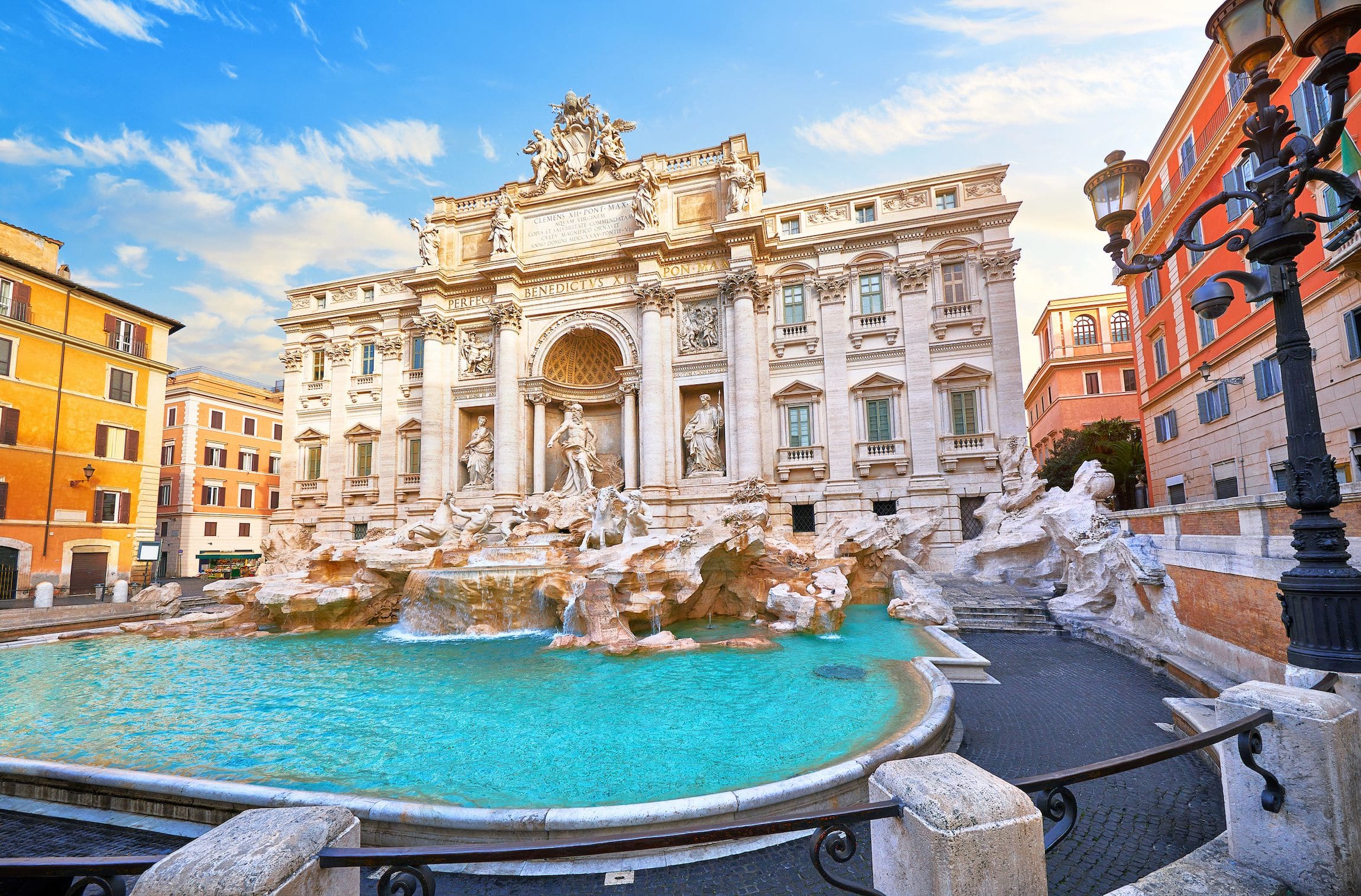
The Trevi Fountain
 Highlight of Grand Tour of Historic Center, Guided
Highlight of Grand Tour of Historic Center, GuidedAdmire one of the most iconic sights in Rome, made famous by Anita Ekberg in La Dolce Vita.
The Trevi Fountain is one of the most iconic sights in Rome thanks to the antics of the shapely Anita Ekberg casting herself into its waters in Frederico Fellini’s cinematic masterpiece, La Dolce Vita. The fountain curiously seems to appear out of virtually nowhere within a warren of backstreets but is nevertheless discovered reasonably early each day by endless crowds of tourists looking to ensure their future return to Rome by tossing a coin back over their should into its crystal clear water (the coins are raked up each morning and donated to the Church organization Caritas).
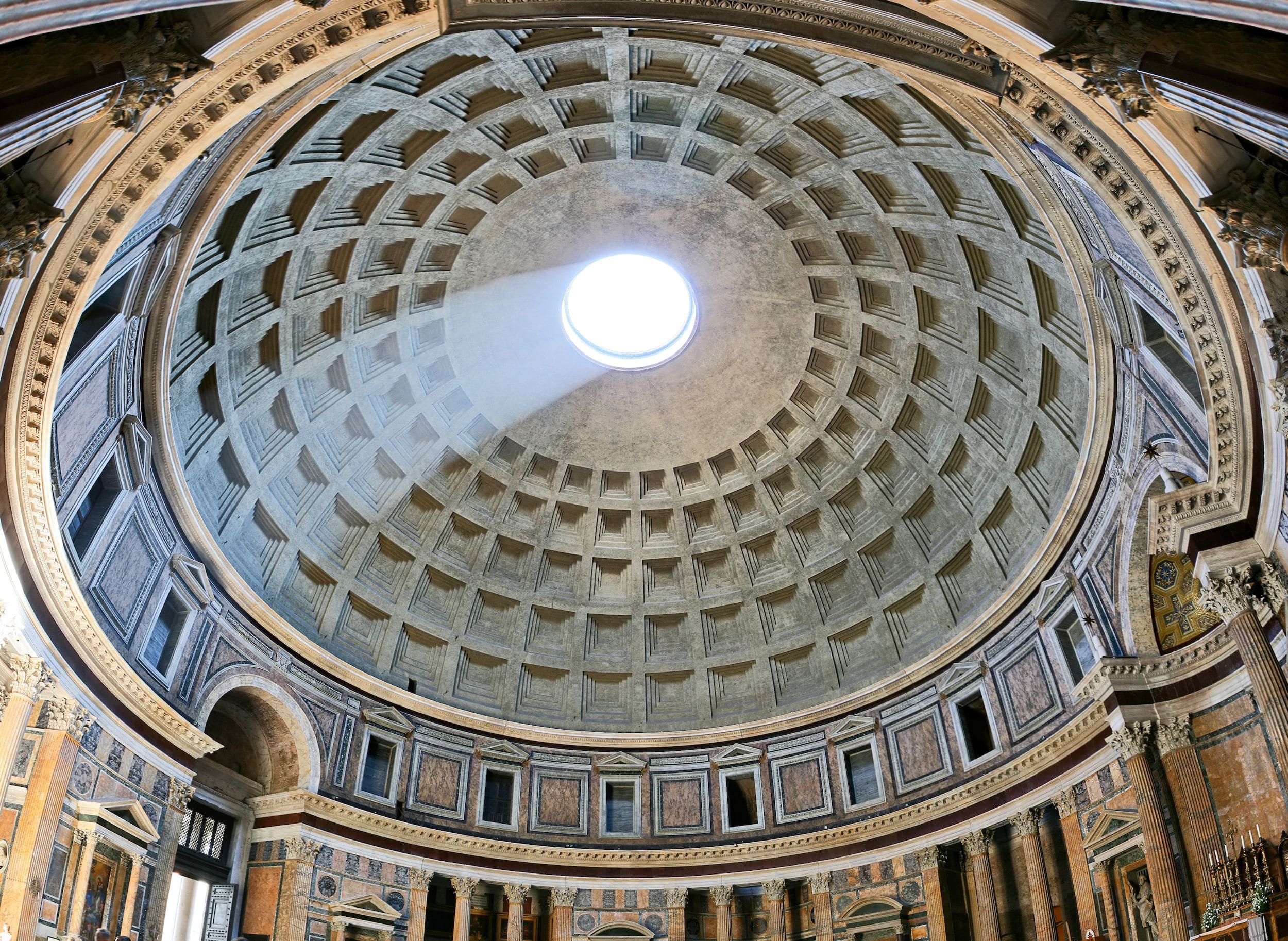
Pantheon
 Highlight of Grand Tour of Historic Center, Guided
Highlight of Grand Tour of Historic Center, GuidedVisit this iconic former pagan temple converted into a Christian church.
This sanctuary of impressive dimensions is one of the best-preserved buildings of ancient Rome. Erected on the foundations of an earlier temple dating back to 27 BC, its construction was ordered by the Emporer Hadrian in the second century AD. The Pantheon was originally a Pagan temple dedidated to all of the gods. The building's consecration as a church in 609 AD saved it from the abandonment, destruction, and the worst of the spoliation that befell the majority of ancient Rome's buildings during the early medieval period. Its greying exterior may look its age, but inside, a spectacular experience awaits. With light streaming through its oculus, the marble-clad interior seems vast. The Pantheon is home to some notable tombs, including those of painters Annibale Carracci and Raphael and King Vittorio Emanuele II.

Spanish Steps
 Highlight of Grand Tour of Historic Center, Guided
Highlight of Grand Tour of Historic Center, GuidedTake a scenic walk up the 18th-century stairway where Audrey Hepburn and Gregory Peck set out on their Roman Holiday.
The majestically balustraded Spanish Steps were built in 1723-6 to connect the piazza with the church of the Trinita dei Monti and the Pincio. It quickly became a favorite spot of poets, artists, and writers who gathered on its 137 steps, and it's now a favorite stop for tourists from all over the world. Yet this highly attractive stairway still somehow manages to retain a sense of romance even at the height of the tourist season, and if you happen to get there at the beginning of May you’ll find it laden with tubs of magnificent azaleas. A masterpiece of 18th-century town planning, the steps actually contain a religious message – the three flights and three landings are an allusion to the Holy Trinity.

The Trevi Fountain
 Highlight of Grand Tour of Historic Center, Guided
Highlight of Grand Tour of Historic Center, GuidedAdmire one of the most iconic sights in Rome, made famous by Anita Ekberg in La Dolce Vita.
The Trevi Fountain is one of the most iconic sights in Rome thanks to the antics of the shapely Anita Ekberg casting herself into its waters in Frederico Fellini’s cinematic masterpiece, La Dolce Vita. The fountain curiously seems to appear out of virtually nowhere within a warren of backstreets but is nevertheless discovered reasonably early each day by endless crowds of tourists looking to ensure their future return to Rome by tossing a coin back over their should into its crystal clear water (the coins are raked up each morning and donated to the Church organization Caritas).

Pantheon
 Highlight of Grand Tour of Historic Center, Guided
Highlight of Grand Tour of Historic Center, GuidedVisit this iconic former pagan temple converted into a Christian church.
This sanctuary of impressive dimensions is one of the best-preserved buildings of ancient Rome. Erected on the foundations of an earlier temple dating back to 27 BC, its construction was ordered by the Emporer Hadrian in the second century AD. The Pantheon was originally a Pagan temple dedidated to all of the gods. The building's consecration as a church in 609 AD saved it from the abandonment, destruction, and the worst of the spoliation that befell the majority of ancient Rome's buildings during the early medieval period. Its greying exterior may look its age, but inside, a spectacular experience awaits. With light streaming through its oculus, the marble-clad interior seems vast. The Pantheon is home to some notable tombs, including those of painters Annibale Carracci and Raphael and King Vittorio Emanuele II.

Spanish Steps
 Highlight of Grand Tour of Historic Center, Guided
Highlight of Grand Tour of Historic Center, GuidedTake a scenic walk up the 18th-century stairway where Audrey Hepburn and Gregory Peck set out on their Roman Holiday.
The majestically balustraded Spanish Steps were built in 1723-6 to connect the piazza with the church of the Trinita dei Monti and the Pincio. It quickly became a favorite spot of poets, artists, and writers who gathered on its 137 steps, and it's now a favorite stop for tourists from all over the world. Yet this highly attractive stairway still somehow manages to retain a sense of romance even at the height of the tourist season, and if you happen to get there at the beginning of May you’ll find it laden with tubs of magnificent azaleas. A masterpiece of 18th-century town planning, the steps actually contain a religious message – the three flights and three landings are an allusion to the Holy Trinity.
prev
next


Day 3
Rome
View More
Day 3
Rome



Morning
Castel Sant'Angelo
Designed and built by Emperor Hadrian as his own mausoleum, the great circular hulk of Castel Sant'Angelo provides one of the best routes to the Vatican and St Peter's via the Ponte Sant'Angelo bridge. Appropriated by the popes, the mausoleum was turned into a fortress and attached to the Vatican with a passageway for the popes to use as a refuge in times of siege or invasion - this is where Pope Clement VII sheltered during the Sack of Rome in 1527.

Mausoleum of Hadrian
Visit this iconic 2nd Century Castle built as the Mausoleum For Emperor Hadrian.
Show More

Ponte Sant'Angelo
Walk across this pedestrian bridge that was built in 134 A.D. by Emperor Hadrian.
Show More

Mausoleum of Hadrian
Visit this iconic 2nd Century Castle built as the Mausoleum For Emperor Hadrian.
Show More

Ponte Sant'Angelo
Walk across this pedestrian bridge that was built in 134 A.D. by Emperor Hadrian.
Show More

Mausoleum of Hadrian
Visit this iconic 2nd Century Castle built as the Mausoleum For Emperor Hadrian.
Show More

Ponte Sant'Angelo
Walk across this pedestrian bridge that was built in 134 A.D. by Emperor Hadrian.
Show More
prev
next

Day 3
Rome
View More

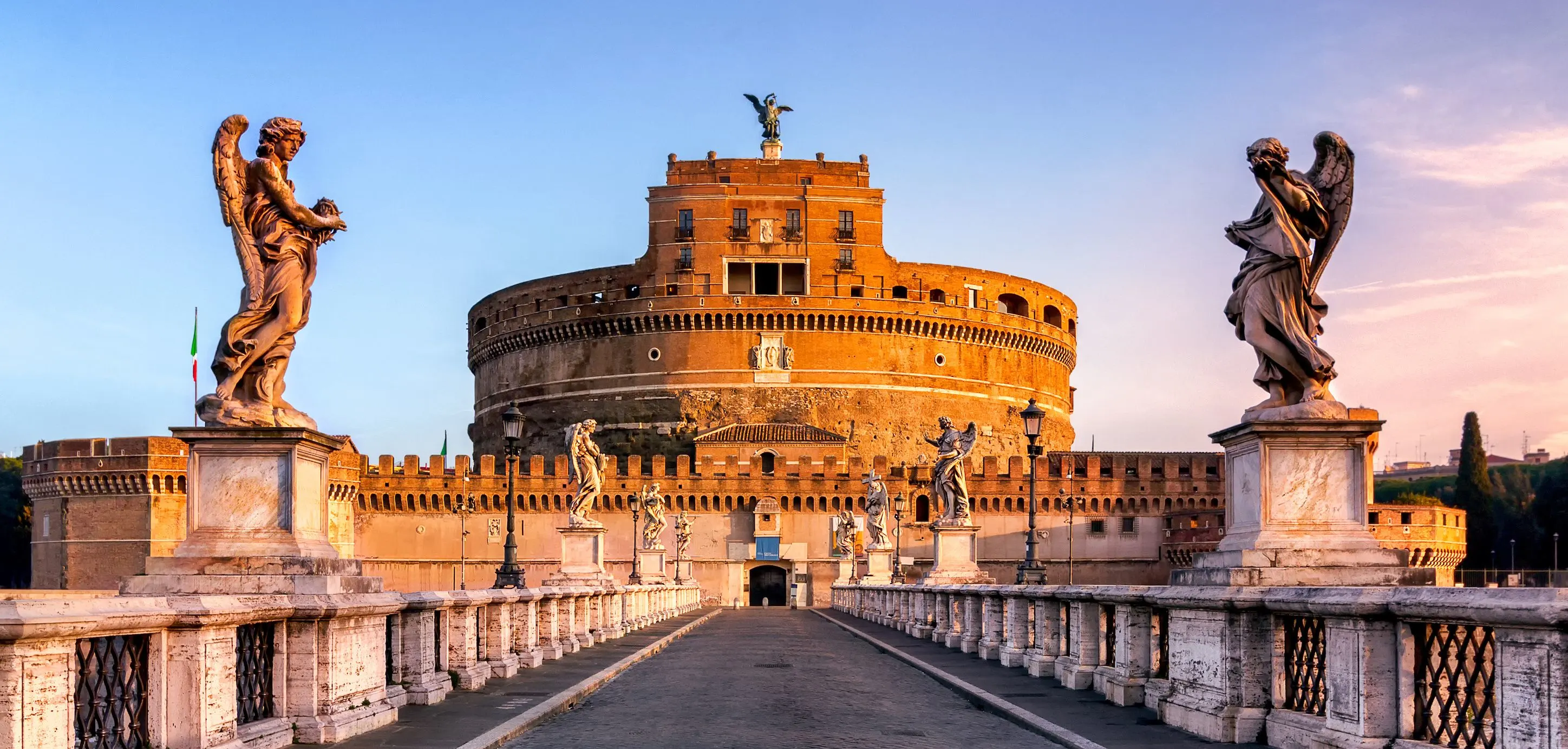
Mausoleum of Hadrian
 Highlight of Castel Sant'Angelo
Highlight of Castel Sant'Angelo Visit this iconic 2nd Century Castle built as the Mausoleum For Emperor Hadrian.
Known as Hadrian's Tomb, the Castel Sant'Angelo is a fortress on the banks of the River Tiber. Originally built as a tomb for the Emperor, it has evolved over the centuries and today it is one of Rome's most underrated museums. Inside you can see the historic Papal apartments, decorated with frescoes from the Renaissance period. Outside you can admire the castle's bastion and rooftop with beautiful views over the river and the Vatican.
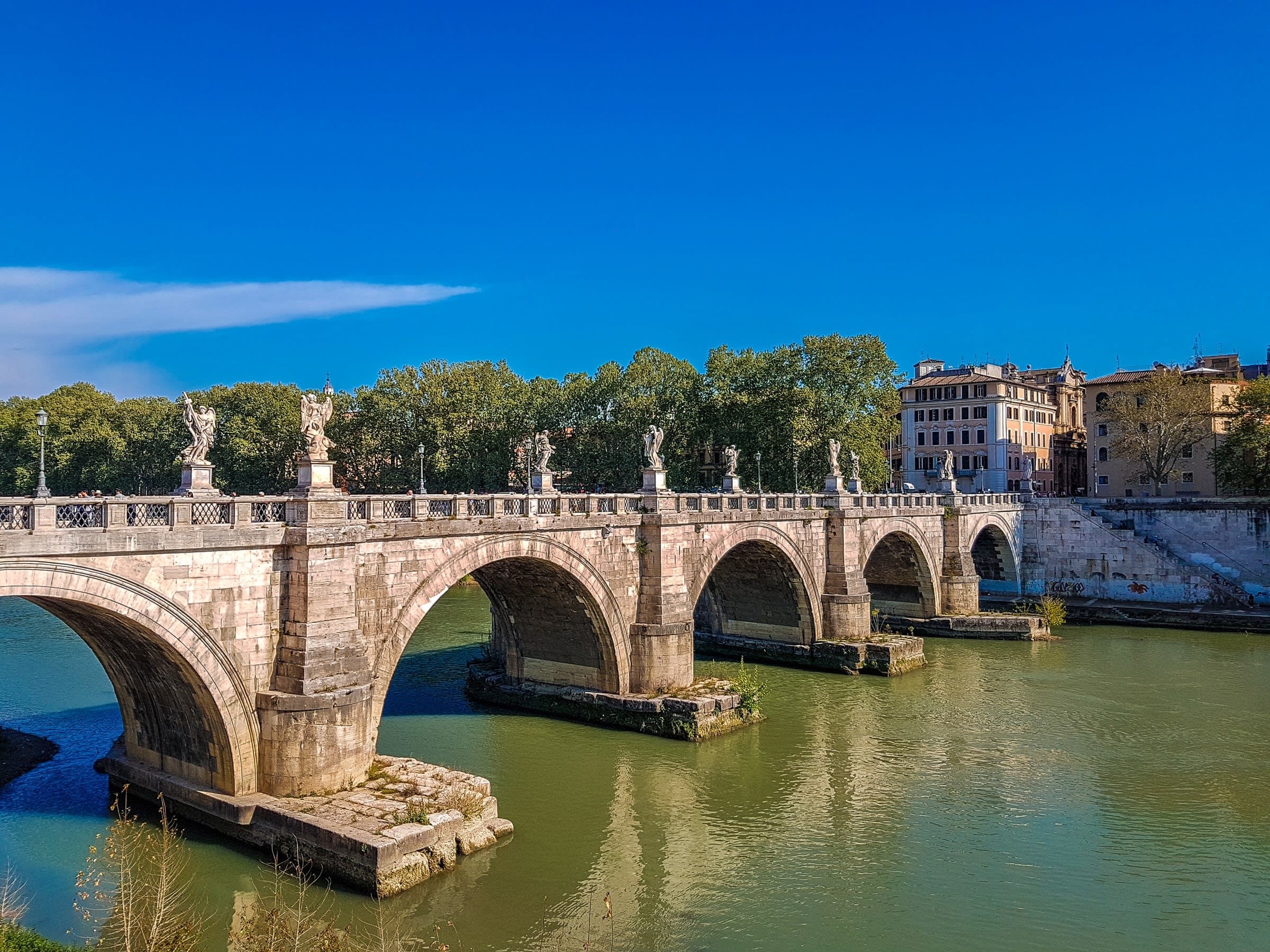
Ponte Sant'Angelo
 Highlight of Castel Sant'Angelo
Highlight of Castel Sant'Angelo Walk across this pedestrian bridge that was built in 134 A.D. by Emperor Hadrian.
Hadrian had the bridge built as an approach to his mausoleum, but it didn't gain its magnificent angel statues by Bernini until late in the 17th century. Spanning the River Tiber, it is completely pedestrianised, which allows for great photo opportunities of the castle and St Peter's Basilica in the near distance.

Mausoleum of Hadrian
 Highlight of Castel Sant'Angelo
Highlight of Castel Sant'Angelo Visit this iconic 2nd Century Castle built as the Mausoleum For Emperor Hadrian.
Known as Hadrian's Tomb, the Castel Sant'Angelo is a fortress on the banks of the River Tiber. Originally built as a tomb for the Emperor, it has evolved over the centuries and today it is one of Rome's most underrated museums. Inside you can see the historic Papal apartments, decorated with frescoes from the Renaissance period. Outside you can admire the castle's bastion and rooftop with beautiful views over the river and the Vatican.

Ponte Sant'Angelo
 Highlight of Castel Sant'Angelo
Highlight of Castel Sant'Angelo Walk across this pedestrian bridge that was built in 134 A.D. by Emperor Hadrian.
Hadrian had the bridge built as an approach to his mausoleum, but it didn't gain its magnificent angel statues by Bernini until late in the 17th century. Spanning the River Tiber, it is completely pedestrianised, which allows for great photo opportunities of the castle and St Peter's Basilica in the near distance.

Mausoleum of Hadrian
 Highlight of Castel Sant'Angelo
Highlight of Castel Sant'Angelo Visit this iconic 2nd Century Castle built as the Mausoleum For Emperor Hadrian.
Known as Hadrian's Tomb, the Castel Sant'Angelo is a fortress on the banks of the River Tiber. Originally built as a tomb for the Emperor, it has evolved over the centuries and today it is one of Rome's most underrated museums. Inside you can see the historic Papal apartments, decorated with frescoes from the Renaissance period. Outside you can admire the castle's bastion and rooftop with beautiful views over the river and the Vatican.

Ponte Sant'Angelo
 Highlight of Castel Sant'Angelo
Highlight of Castel Sant'Angelo Walk across this pedestrian bridge that was built in 134 A.D. by Emperor Hadrian.
Hadrian had the bridge built as an approach to his mausoleum, but it didn't gain its magnificent angel statues by Bernini until late in the 17th century. Spanning the River Tiber, it is completely pedestrianised, which allows for great photo opportunities of the castle and St Peter's Basilica in the near distance.
prev
next


Day 4
Rome
View More
Day 4
Rome



Morning/Mid-Day
Visit Rome's Esquilino District
Upon first glance, this urban neighborhood of Rome may seem busy and overwhelming, but hidden among its traffic-noisy streets are some of Rome's most beautiful churches, artistic treasures, and cultural museums, including the Baths of Diocletian.

Basilica of Santa Maria degli Angeli
See a Michelangelo-designed church built within the former Baths of Diocletian.
Show More

Palazzo Massimo alle Terme
Visit one of Rome's greatest but most unheralded museums of antiquity.
Show More

Baths of Diocletian
Walk the ruins of what was once the largest themal baths in the ancient Roman world.
Show More

Basilica of Santa Maria degli Angeli
See a Michelangelo-designed church built within the former Baths of Diocletian.
Show More

Palazzo Massimo alle Terme
Visit one of Rome's greatest but most unheralded museums of antiquity.
Show More

Baths of Diocletian
Walk the ruins of what was once the largest themal baths in the ancient Roman world.
Show More

Basilica of Santa Maria degli Angeli
See a Michelangelo-designed church built within the former Baths of Diocletian.
Show More
prev
next

Day 4
Rome
View More

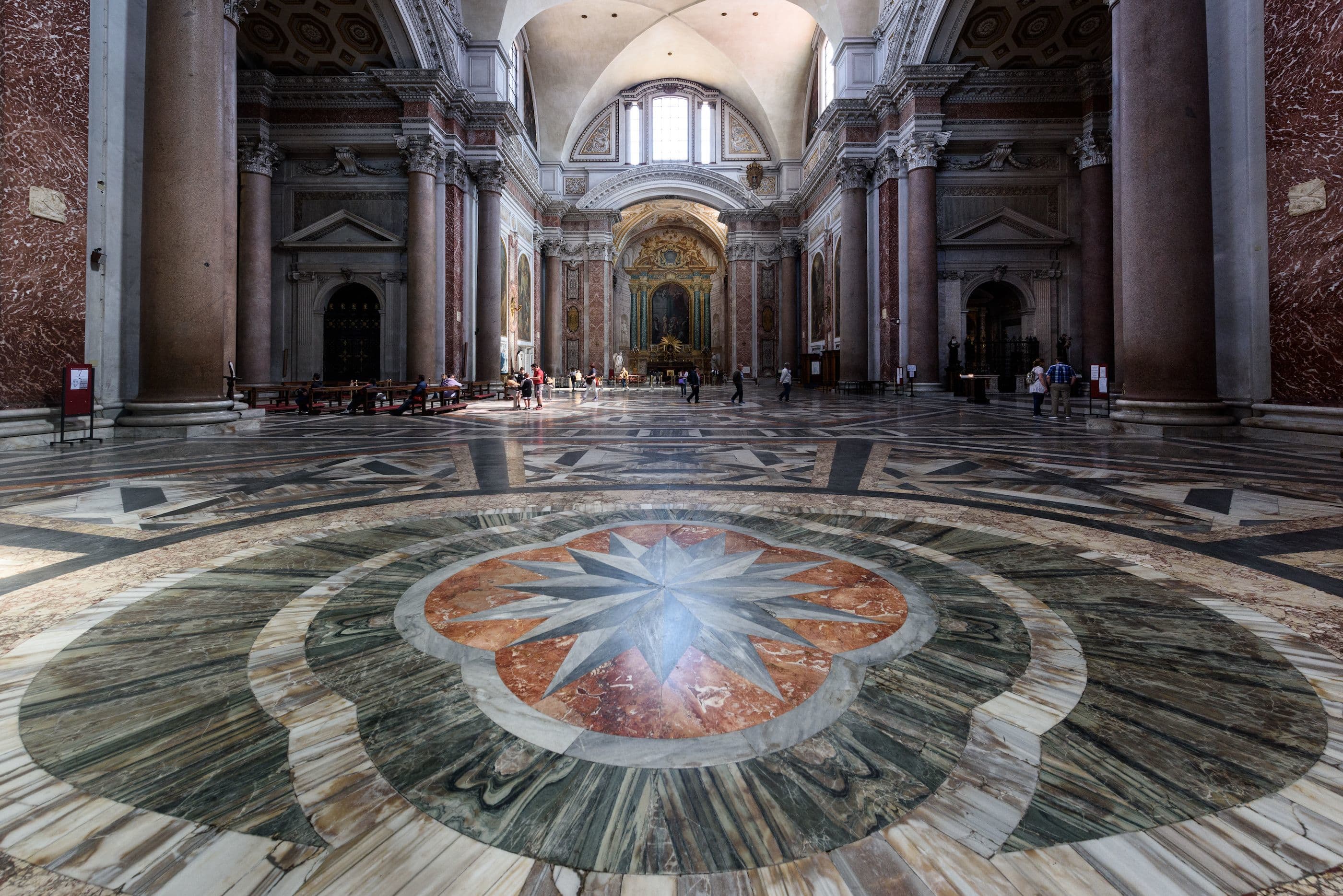
Basilica of Santa Maria degli Angeli
 Highlight of Esquilino District
Highlight of Esquilino DistrictSee a Michelangelo-designed church built within the former Baths of Diocletian.
In 1561, almost 1000 years after the baths of Diocletian fell into disuse, Pope Pius IV decided to build a basilica consecrated to Our Lady of the Angels within the baths. He commisioned the 86-year-old Michelangelo to plan the church, making use of some of the existing structures of the baths. Today a visit to the basilica gives you an idea of the enormous size of the baths. The church was constructed at the site of the former frigidarium (a large cold pool which would be used to close the pores after using the hot baths) and incorporates several elements of the former thermae. The vestibule occupies the former tepidarium (a Roman-style relaxation room) and the imposing entrance is an exedra of the caldarium (a room with a hot plunge bath). Other highlights include the meridian solar line running across the floor, which still accurately calculates the length of the year and the summer and winter solstices. There is also an impressive organ with 5,400 tubes. It is capable of leaving those visitors lucky enough to hear it spellbound.
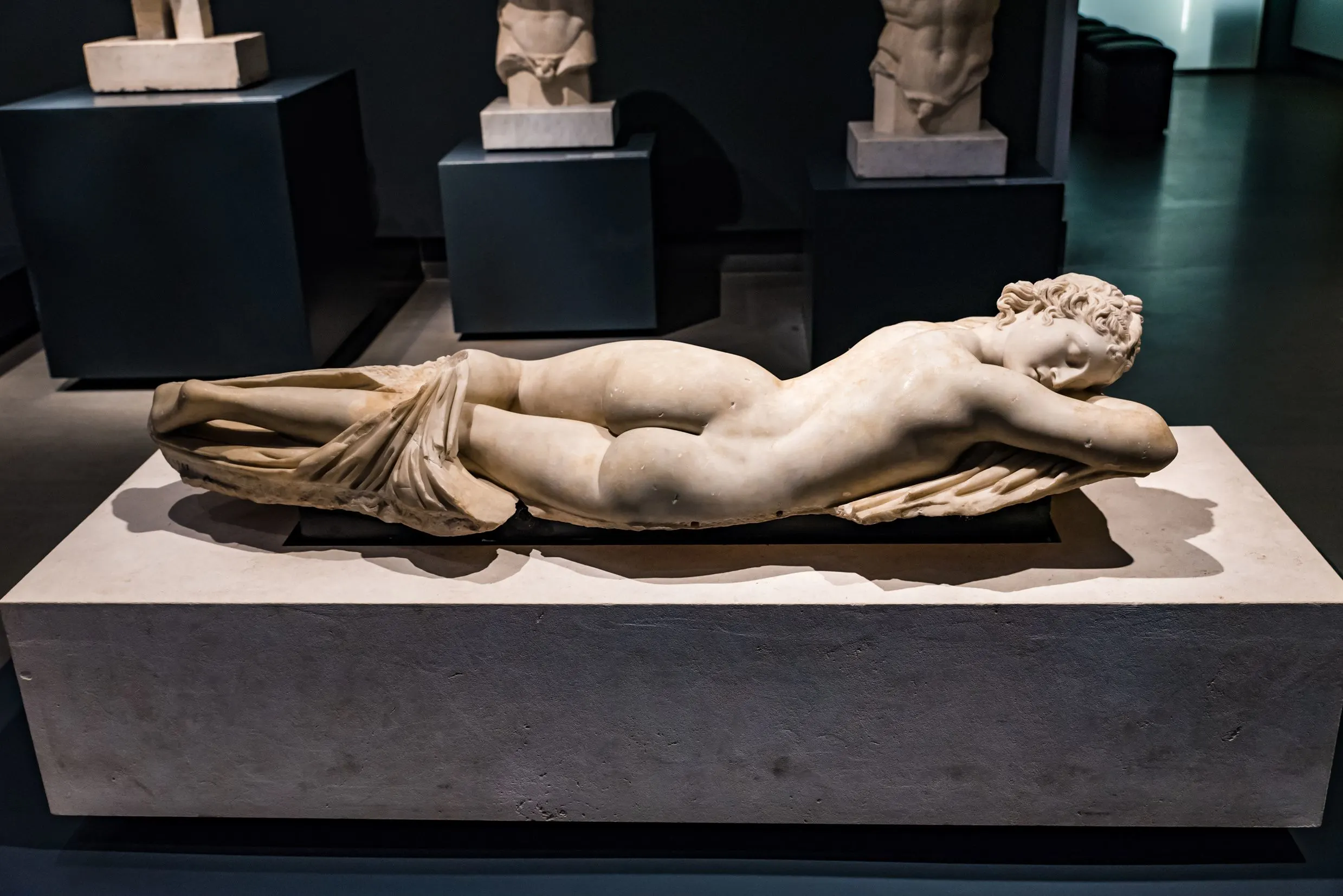
Palazzo Massimo alle Terme
 Highlight of Esquilino District
Highlight of Esquilino DistrictVisit one of Rome's greatest but most unheralded museums of antiquity.
This light-filled museum holds one of the best classical art collections in the world. The ground and first-floor feature famous Greek and Roman sculptures, mosaics and statues, as well as impressive sarcophagi and high reliefs. The second floor showcases the best preserved Roman frescoes in the world, which are considered the highlight of the museum. Originally located in Villa of Livia (the wife of Augustus) and Villa Farnesina, these colourful frescoes, sometimes covering an entire room, offer a unique view into life in ancient Rome and the critical importance of gardens, nature, and the villa atmosphere to upper echelon Romans. A must visit room is the painted garden room of Villa Livia. There is also a cinema room with a video showing a 3D reconstruction of the Villa Farnesina as it would have been, showing the layout of the rooms in the villa and the frescoes you had seen just moments before.

Baths of Diocletian
 Highlight of Esquilino District
Highlight of Esquilino DistrictWalk the ruins of what was once the largest themal baths in the ancient Roman world.
Covering an area of more than 13 hectares (some 32 acres), the bath complex was commissioned by Emperor Diocletian in 298 AD, with a capacity to host over 3,000 people (twice as many as the Baths of Caracalla). The baths were made of bricks, coated in marble and decorated with mosaics and sculptures. The complex included a gymnasium, a library, a large outdoor swimming pool and cold, hot, and tepid public baths. They remained open until 537 when the Goths cut off the aqueducts in an attempt to conquer Rome. After they fell into disrepair and were left abandoned. Even though only a small part of the public bath complex can be seen and visited, it is extremely impressive, with the possibility to see at some points the high ceilings the baths possessed. The interior includes part of the National Museum of Rome and a permanent exhibition on pre-historic populations of the area. In the outdoor part of the baths, it is possible to stroll through a sixteenth-century garden with nearly 400 works of art, including statues, sarcophagi and reliefs.

Basilica of Santa Maria degli Angeli
 Highlight of Esquilino District
Highlight of Esquilino DistrictSee a Michelangelo-designed church built within the former Baths of Diocletian.
In 1561, almost 1000 years after the baths of Diocletian fell into disuse, Pope Pius IV decided to build a basilica consecrated to Our Lady of the Angels within the baths. He commisioned the 86-year-old Michelangelo to plan the church, making use of some of the existing structures of the baths. Today a visit to the basilica gives you an idea of the enormous size of the baths. The church was constructed at the site of the former frigidarium (a large cold pool which would be used to close the pores after using the hot baths) and incorporates several elements of the former thermae. The vestibule occupies the former tepidarium (a Roman-style relaxation room) and the imposing entrance is an exedra of the caldarium (a room with a hot plunge bath). Other highlights include the meridian solar line running across the floor, which still accurately calculates the length of the year and the summer and winter solstices. There is also an impressive organ with 5,400 tubes. It is capable of leaving those visitors lucky enough to hear it spellbound.

Palazzo Massimo alle Terme
 Highlight of Esquilino District
Highlight of Esquilino DistrictVisit one of Rome's greatest but most unheralded museums of antiquity.
This light-filled museum holds one of the best classical art collections in the world. The ground and first-floor feature famous Greek and Roman sculptures, mosaics and statues, as well as impressive sarcophagi and high reliefs. The second floor showcases the best preserved Roman frescoes in the world, which are considered the highlight of the museum. Originally located in Villa of Livia (the wife of Augustus) and Villa Farnesina, these colourful frescoes, sometimes covering an entire room, offer a unique view into life in ancient Rome and the critical importance of gardens, nature, and the villa atmosphere to upper echelon Romans. A must visit room is the painted garden room of Villa Livia. There is also a cinema room with a video showing a 3D reconstruction of the Villa Farnesina as it would have been, showing the layout of the rooms in the villa and the frescoes you had seen just moments before.

Baths of Diocletian
 Highlight of Esquilino District
Highlight of Esquilino DistrictWalk the ruins of what was once the largest themal baths in the ancient Roman world.
Covering an area of more than 13 hectares (some 32 acres), the bath complex was commissioned by Emperor Diocletian in 298 AD, with a capacity to host over 3,000 people (twice as many as the Baths of Caracalla). The baths were made of bricks, coated in marble and decorated with mosaics and sculptures. The complex included a gymnasium, a library, a large outdoor swimming pool and cold, hot, and tepid public baths. They remained open until 537 when the Goths cut off the aqueducts in an attempt to conquer Rome. After they fell into disrepair and were left abandoned. Even though only a small part of the public bath complex can be seen and visited, it is extremely impressive, with the possibility to see at some points the high ceilings the baths possessed. The interior includes part of the National Museum of Rome and a permanent exhibition on pre-historic populations of the area. In the outdoor part of the baths, it is possible to stroll through a sixteenth-century garden with nearly 400 works of art, including statues, sarcophagi and reliefs.

Basilica of Santa Maria degli Angeli
 Highlight of Esquilino District
Highlight of Esquilino DistrictSee a Michelangelo-designed church built within the former Baths of Diocletian.
In 1561, almost 1000 years after the baths of Diocletian fell into disuse, Pope Pius IV decided to build a basilica consecrated to Our Lady of the Angels within the baths. He commisioned the 86-year-old Michelangelo to plan the church, making use of some of the existing structures of the baths. Today a visit to the basilica gives you an idea of the enormous size of the baths. The church was constructed at the site of the former frigidarium (a large cold pool which would be used to close the pores after using the hot baths) and incorporates several elements of the former thermae. The vestibule occupies the former tepidarium (a Roman-style relaxation room) and the imposing entrance is an exedra of the caldarium (a room with a hot plunge bath). Other highlights include the meridian solar line running across the floor, which still accurately calculates the length of the year and the summer and winter solstices. There is also an impressive organ with 5,400 tubes. It is capable of leaving those visitors lucky enough to hear it spellbound.
prev
next


Day 5
Rome to Florence
View More
Day 5
Rome to Florence




Morning/Mid-Day
Traveling the Via Appia on Foot or Bicycle
One of the earliest and strategically most important Roman roads of the ancient republic, the Via Appia (or Appian Way) once spanned 350 miles (563km), all the way from the Roman Forum in Rome to modern-day Brindisi. On the south side of Rome lies one of the best preserved stretches of the road, the Via Apia Antica. Take an afternoon to explore the ruins, catacombs, and sights along this infamously cobbled way. Exploring on foot is a relaxed and easy way to do it, made easier by the fact that bus stops along the way mean you don't have to backtrack. Bike rentals are also available and are a good way to cover as much ground as possible. But as an ancient cobbled road, sections of this walk are very bumpy, and depending on which route you take, you may encounter traffic. So you may want to consider if biking with a guided tour makes more sense.

Catacombs of San Callisto (i.e. St. Callixtus)
Discover the crypt and catacombs of an ancient Christian burial site estimated to hold half a million bodies.
Show More

Catacombs of San Callisto (i.e. St. Callixtus)
Discover the crypt and catacombs of an ancient Christian burial site estimated to hold half a million bodies.
Show More

Catacombs of San Callisto (i.e. St. Callixtus)
Discover the crypt and catacombs of an ancient Christian burial site estimated to hold half a million bodies.
Show More

Catacombs of San Callisto (i.e. St. Callixtus)
Discover the crypt and catacombs of an ancient Christian burial site estimated to hold half a million bodies.
Show More

Catacombs of San Callisto (i.e. St. Callixtus)
Discover the crypt and catacombs of an ancient Christian burial site estimated to hold half a million bodies.
Show More
prev
next

Day 5
Rome to Florence
View More

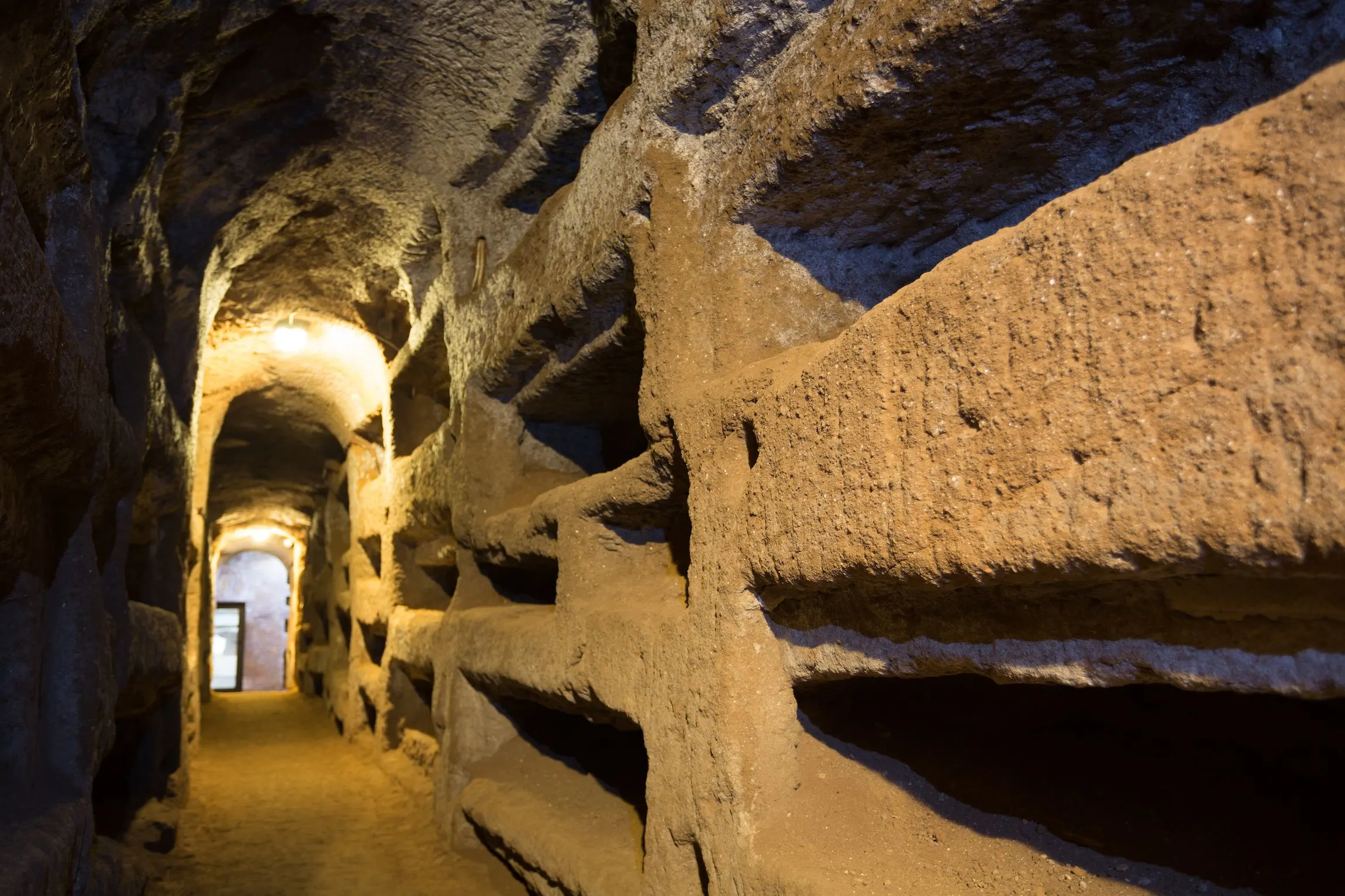
Catacombs of San Callisto (i.e. St. Callixtus)
 Highlight of Via Appia Antica
Highlight of Via Appia AnticaDiscover the crypt and catacombs of an ancient Christian burial site estimated to hold half a million bodies.
The catacombs are the most important landmark along the ancient Appian Way route because they include the Crypt of the Popes, which contained the remains of nine popes buried between the 2nd and 4th centuries. In times of persecution, the catacombs also provided a secret place of worship for early Christians. There are five levels and roughly 12 miles (20km) of passageways. Over time, the catacombs were mostly forgotten as the relics of the popes and saints they contained had been moved to different churces of Rome. It was not until the 19th century that Italian architects rediscovered it.

Catacombs of San Callisto (i.e. St. Callixtus)
 Highlight of Via Appia Antica
Highlight of Via Appia AnticaDiscover the crypt and catacombs of an ancient Christian burial site estimated to hold half a million bodies.
The catacombs are the most important landmark along the ancient Appian Way route because they include the Crypt of the Popes, which contained the remains of nine popes buried between the 2nd and 4th centuries. In times of persecution, the catacombs also provided a secret place of worship for early Christians. There are five levels and roughly 12 miles (20km) of passageways. Over time, the catacombs were mostly forgotten as the relics of the popes and saints they contained had been moved to different churces of Rome. It was not until the 19th century that Italian architects rediscovered it.

Catacombs of San Callisto (i.e. St. Callixtus)
 Highlight of Via Appia Antica
Highlight of Via Appia AnticaDiscover the crypt and catacombs of an ancient Christian burial site estimated to hold half a million bodies.
The catacombs are the most important landmark along the ancient Appian Way route because they include the Crypt of the Popes, which contained the remains of nine popes buried between the 2nd and 4th centuries. In times of persecution, the catacombs also provided a secret place of worship for early Christians. There are five levels and roughly 12 miles (20km) of passageways. Over time, the catacombs were mostly forgotten as the relics of the popes and saints they contained had been moved to different churces of Rome. It was not until the 19th century that Italian architects rediscovered it.

Catacombs of San Callisto (i.e. St. Callixtus)
 Highlight of Via Appia Antica
Highlight of Via Appia AnticaDiscover the crypt and catacombs of an ancient Christian burial site estimated to hold half a million bodies.
The catacombs are the most important landmark along the ancient Appian Way route because they include the Crypt of the Popes, which contained the remains of nine popes buried between the 2nd and 4th centuries. In times of persecution, the catacombs also provided a secret place of worship for early Christians. There are five levels and roughly 12 miles (20km) of passageways. Over time, the catacombs were mostly forgotten as the relics of the popes and saints they contained had been moved to different churces of Rome. It was not until the 19th century that Italian architects rediscovered it.

Catacombs of San Callisto (i.e. St. Callixtus)
 Highlight of Via Appia Antica
Highlight of Via Appia AnticaDiscover the crypt and catacombs of an ancient Christian burial site estimated to hold half a million bodies.
The catacombs are the most important landmark along the ancient Appian Way route because they include the Crypt of the Popes, which contained the remains of nine popes buried between the 2nd and 4th centuries. In times of persecution, the catacombs also provided a secret place of worship for early Christians. There are five levels and roughly 12 miles (20km) of passageways. Over time, the catacombs were mostly forgotten as the relics of the popes and saints they contained had been moved to different churces of Rome. It was not until the 19th century that Italian architects rediscovered it.
prev
next

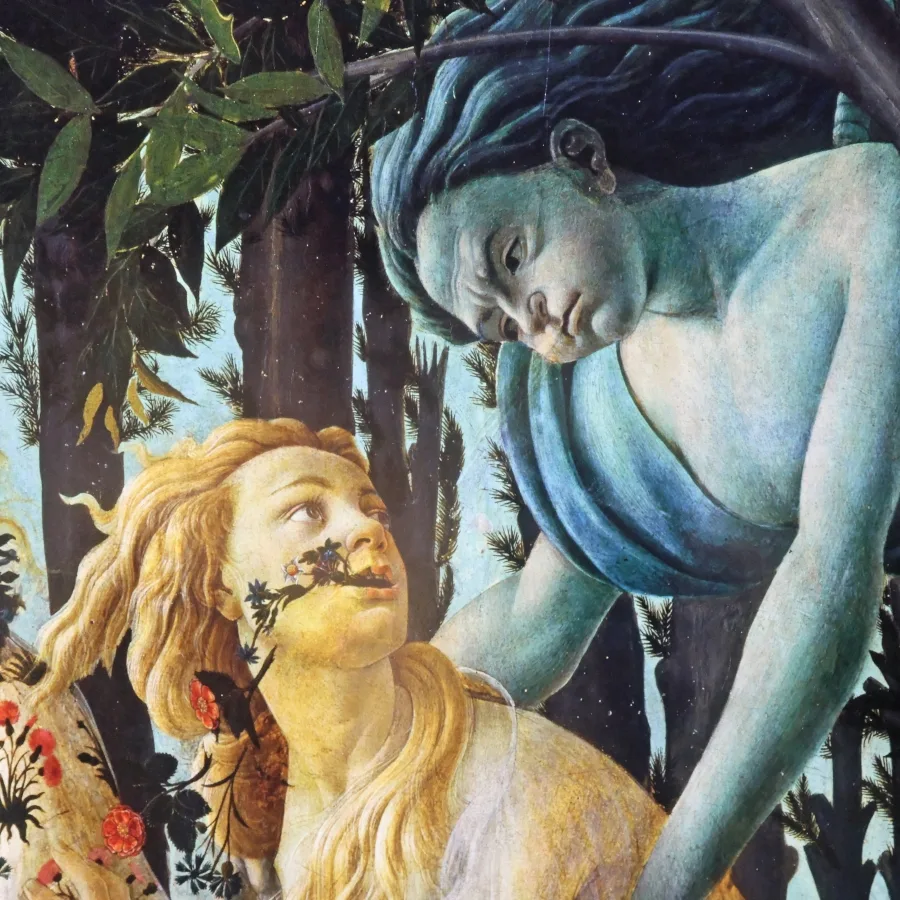
Day 6
Florence
View More
Day 6
Florence



Morning/Mid-Day
Visit Italy's Greatest Display of Art at the Uffizi Gallery
As the capital of the Renaissance, it's only fitting that Florence should also host Italy's greatest art gallery at the Uffizi. It's understandably busy throughout the year, but it's nevertheless worth the crowds to see to see some of the most sumptuous masterpieces of Renaissance art, including Botticelli's Primavera and Venus, and works by Michelangelo and Da Vinci. If you're planning to visit other galleries and museums in Florence, then it's definitely worth investing in a Firenze Card, which gives you free entry and priority access to 72 venues in the city. At a minimum, you should book ahead for the Uffizi to avoid very long queues.

Day 6
Florence
View More


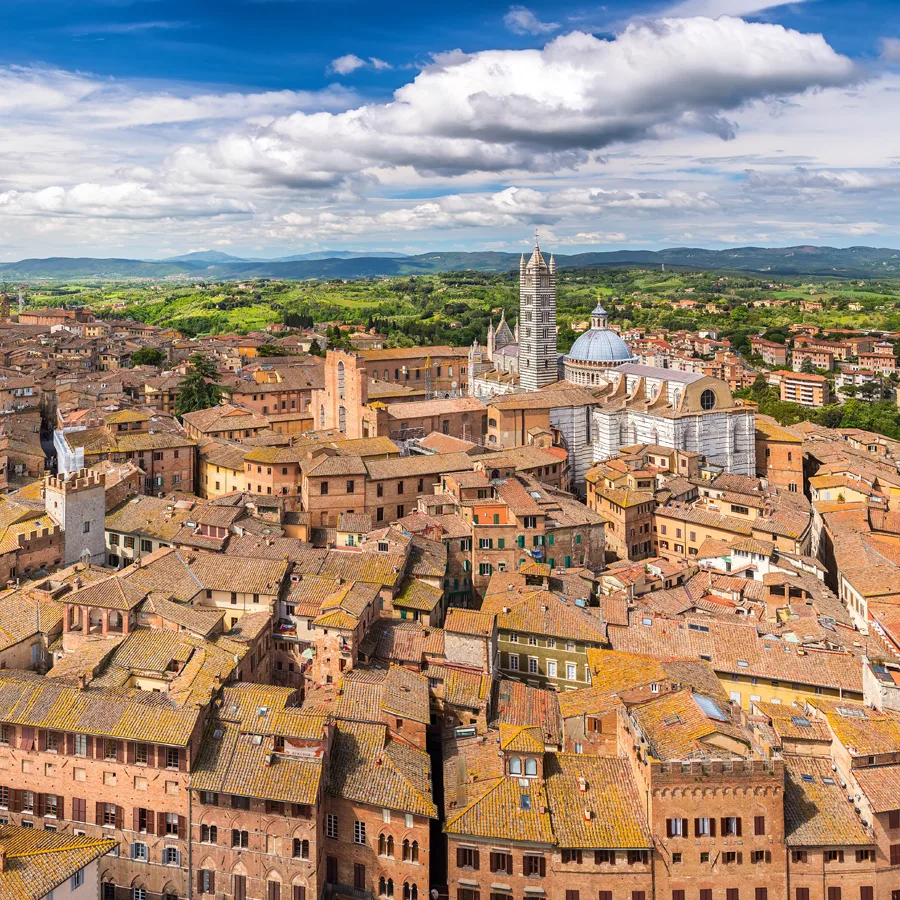
Day 7
Florence
View More
Day 7
Florence

Early Morning to Afternoon
Excursion to the Medieval Hilltop Town of Siena
For beauty and interest in Tuscany, only Siena comes close to Florence. Only an hour-and-a-half from Florence by train, it makes for a perfect day trip. The mesmerising brick-built medieval town with its narrow streets winding down into the valleys below was once a great regional power which rivaled Florence, and famously defeated the larger town in the legendary Battle of Montaperti. Its main square, the Campo, is one of the most satisfying urban spaces ever built, playing host to the annual Palio horse race in which each of the town's 17 contrade (i.e. city districts) participate. The traffic-free streets have been wonderfully preserved and its great Gothic buildings still exhibit the artistic masterpieces of the Sienese school of painting commissioned for them during the town's heyday in the 14th century.

Pinacoteca Nazionale
Make time to visit this gallery holding precious art and history from the Gothic era, when Siena's power and influence peaked.
Show More

Duomo di Siena
Experience a riot of the senses as you walk into one of Tuscany's most colorful and remarkable cathedrals.
Show More

Piazza del Campo
Stop and linger in one of the more glorious and satisfying urban spaces ever built.
Show More

Palazzo Pubblico and Museo Civico
Make your way into the courtyard of this brick palace built in the 13th century and enter the Museo Civico, where you will marvel at the beautiful murals which adorn the interiors.
Show More

Pinacoteca Nazionale
Make time to visit this gallery holding precious art and history from the Gothic era, when Siena's power and influence peaked.
Show More

Duomo di Siena
Experience a riot of the senses as you walk into one of Tuscany's most colorful and remarkable cathedrals.
Show More

Piazza del Campo
Stop and linger in one of the more glorious and satisfying urban spaces ever built.
Show More

Palazzo Pubblico and Museo Civico
Make your way into the courtyard of this brick palace built in the 13th century and enter the Museo Civico, where you will marvel at the beautiful murals which adorn the interiors.
Show More
prev
next

Day 7
Florence
View More

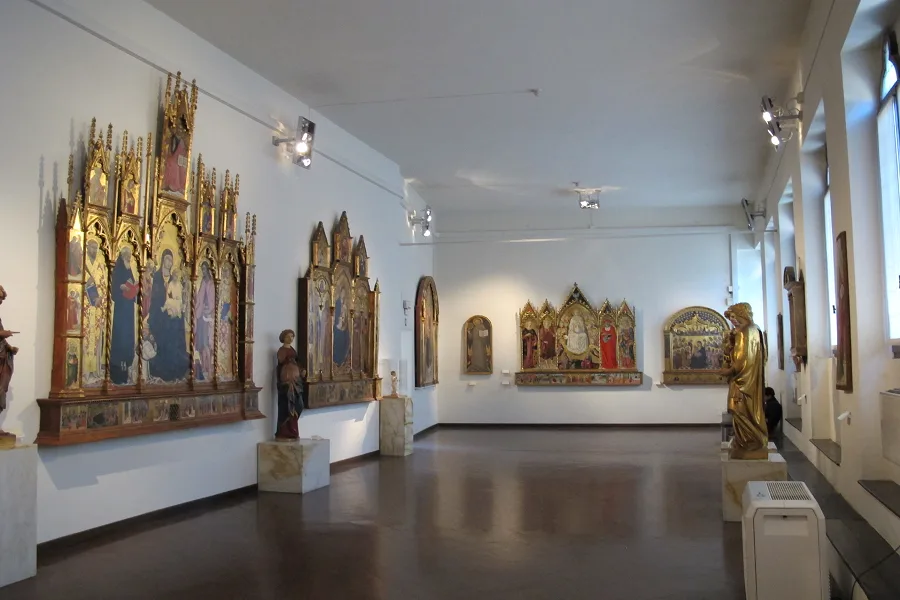
Pinacoteca Nazionale
 Highlight of Siena Excursion
Highlight of Siena ExcursionMake time to visit this gallery holding precious art and history from the Gothic era, when Siena's power and influence peaked.
This is the main state art museum of the city and includes a rich collection of masterpieces from the famous Sienese school of artists, which created mainly large, majestic altarpieces with golden decorations. The "gold" background paintings include a piece by Master of Tressa which marks the beginning of the golden age of Sienese painting.
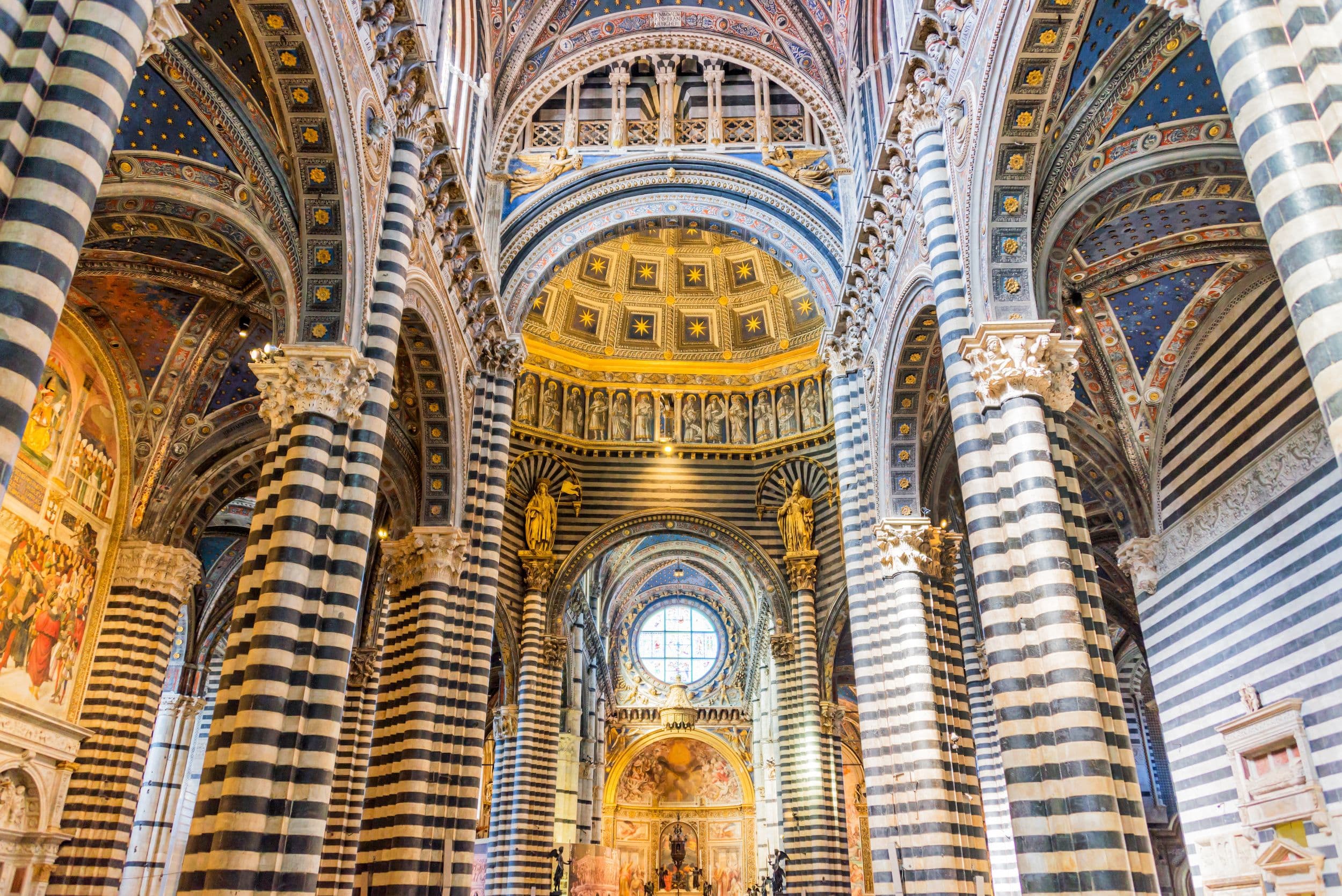
Duomo di Siena
 Highlight of Siena Excursion
Highlight of Siena ExcursionExperience a riot of the senses as you walk into one of Tuscany's most colorful and remarkable cathedrals.
Siena's Duomo is a fabulous conglomeration of Romanesque and Gothic architecture, delineated by encircling bands of black and white marble. It is the earliest of all the great Tuscan cathedrals, having been mostly completed by 1263. Before you enter, take a moment to admire the marble facade and its remarkable statuary. Once inside, you can invest in the audio guide to get the most out of a visit. The standout artistic treasure is the pulpit with columns resting on the backs of alternating lions and lionesses. The Piccolomini Library was added on to the cathedral in 1495 by the future Pope Pius III, and is one of the loveliest rooms in all Italy thanks to its cycle of crystal-sharp, brilliantly colorful frescoes.

Piazza del Campo
 Highlight of Siena Excursion
Highlight of Siena ExcursionStop and linger in one of the more glorious and satisfying urban spaces ever built.
With its remarkable fan shape and gentle slope, the Piazza del Campo is one of the more memorable and unique public squares in Europe. It has been heart of Siena since the mid-12th century when it was built on the site of a Roman marketplace. Cafes line the square offering coffee and aperitivo for the young and old alike who relax and take in the scene. The piazza is made doubly famous by the fact that it hosts the annual Palio horse race, a hotly-contested event which splits the city into competing factions.
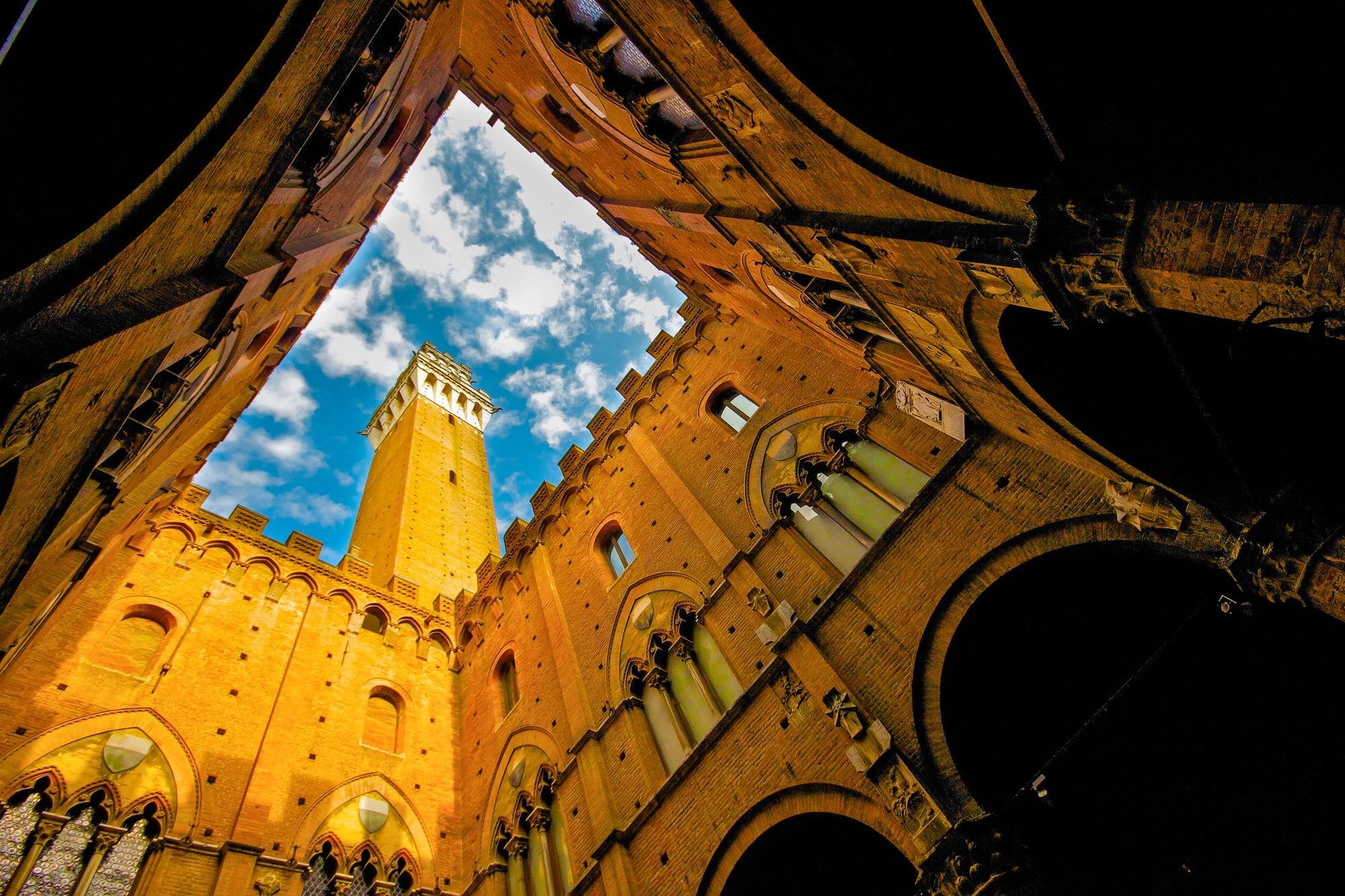
Palazzo Pubblico and Museo Civico
 Highlight of Siena Excursion
Highlight of Siena ExcursionMake your way into the courtyard of this brick palace built in the 13th century and enter the Museo Civico, where you will marvel at the beautiful murals which adorn the interiors.
Dominating the Piazza del Campo, this 13th century palace and tower was built as a symbol of the independence and wealth of Siena by the Government of Nine (Governo dei Nove) - nine representatives of the people elected by the merchant class, not noble families. Looking at its façade from the Piazza del Campo, it's possible to immediately see its different periods of construction: on the lower level of the three-mullioned (triple-arched) windows the stone that was used and then later brick. The 400 steps to the top of the palace tower is no easy feat even for the fittest of travelers, but the view over the city and Piazza del Campo below make the narrow ascent worth it. Inside the palace courtyard you will find the entrance to the Museo Civico, a treasure trove of magnificent works of art which can be seen inside the palace. One of the most beautiful rooms in the palace is the Sala dei Nove, the Hall of the Nine, with the Allegories of Good and Bad Government by Ambrogio Lorenzetti where you can see the medieval city with its workshops and artisans.

Pinacoteca Nazionale
 Highlight of Siena Excursion
Highlight of Siena ExcursionMake time to visit this gallery holding precious art and history from the Gothic era, when Siena's power and influence peaked.
This is the main state art museum of the city and includes a rich collection of masterpieces from the famous Sienese school of artists, which created mainly large, majestic altarpieces with golden decorations. The "gold" background paintings include a piece by Master of Tressa which marks the beginning of the golden age of Sienese painting.

Duomo di Siena
 Highlight of Siena Excursion
Highlight of Siena ExcursionExperience a riot of the senses as you walk into one of Tuscany's most colorful and remarkable cathedrals.
Siena's Duomo is a fabulous conglomeration of Romanesque and Gothic architecture, delineated by encircling bands of black and white marble. It is the earliest of all the great Tuscan cathedrals, having been mostly completed by 1263. Before you enter, take a moment to admire the marble facade and its remarkable statuary. Once inside, you can invest in the audio guide to get the most out of a visit. The standout artistic treasure is the pulpit with columns resting on the backs of alternating lions and lionesses. The Piccolomini Library was added on to the cathedral in 1495 by the future Pope Pius III, and is one of the loveliest rooms in all Italy thanks to its cycle of crystal-sharp, brilliantly colorful frescoes.

Piazza del Campo
 Highlight of Siena Excursion
Highlight of Siena ExcursionStop and linger in one of the more glorious and satisfying urban spaces ever built.
With its remarkable fan shape and gentle slope, the Piazza del Campo is one of the more memorable and unique public squares in Europe. It has been heart of Siena since the mid-12th century when it was built on the site of a Roman marketplace. Cafes line the square offering coffee and aperitivo for the young and old alike who relax and take in the scene. The piazza is made doubly famous by the fact that it hosts the annual Palio horse race, a hotly-contested event which splits the city into competing factions.

Palazzo Pubblico and Museo Civico
 Highlight of Siena Excursion
Highlight of Siena ExcursionMake your way into the courtyard of this brick palace built in the 13th century and enter the Museo Civico, where you will marvel at the beautiful murals which adorn the interiors.
Dominating the Piazza del Campo, this 13th century palace and tower was built as a symbol of the independence and wealth of Siena by the Government of Nine (Governo dei Nove) - nine representatives of the people elected by the merchant class, not noble families. Looking at its façade from the Piazza del Campo, it's possible to immediately see its different periods of construction: on the lower level of the three-mullioned (triple-arched) windows the stone that was used and then later brick. The 400 steps to the top of the palace tower is no easy feat even for the fittest of travelers, but the view over the city and Piazza del Campo below make the narrow ascent worth it. Inside the palace courtyard you will find the entrance to the Museo Civico, a treasure trove of magnificent works of art which can be seen inside the palace. One of the most beautiful rooms in the palace is the Sala dei Nove, the Hall of the Nine, with the Allegories of Good and Bad Government by Ambrogio Lorenzetti where you can see the medieval city with its workshops and artisans.
prev
next


Day 8
Florence
View More
Day 8
Florence


Morning/Mid-Day
In the footsteps of the Medicis - Ponte Vecchio & Palazzo Pitti
The Ponte Vecchio, an iconic bridge over the Arno River, dates back to Roman times and is a key Florence landmark. Once home to butchers, it now houses jewelers and art dealers. The Vasari Corridor above was a Medici family passage linking the Palazzo Vecchio with the Pitti Palace, a treasure trove of Italian Renaissance and Baroque art by Raphael, Titian, and others. Walk across this magnificent bridge that connects the two sides of the city and learn about its history along the way.

Palazzo Pitti
Discover some of the Florence's best but often overlooked museums in the former palace of the Grand Dukes of Tuscany.
Show More

Boboli Gardens
Join locals and tourists alike in a park which the Medici's poured their hearts (and money) into creating.
Show More

Palazzo Pitti
Discover some of the Florence's best but often overlooked museums in the former palace of the Grand Dukes of Tuscany.
Show More

Boboli Gardens
Join locals and tourists alike in a park which the Medici's poured their hearts (and money) into creating.
Show More

Palazzo Pitti
Discover some of the Florence's best but often overlooked museums in the former palace of the Grand Dukes of Tuscany.
Show More

Boboli Gardens
Join locals and tourists alike in a park which the Medici's poured their hearts (and money) into creating.
Show More
prev
next

Day 8
Florence
View More


Palazzo Pitti
 Highlight of Palazzo Pitti
Highlight of Palazzo PittiDiscover some of the Florence's best but often overlooked museums in the former palace of the Grand Dukes of Tuscany.
You'll find the Pitti Palace just a few steps from the Ponte Vecchio. In 1457, wealthy banker Luca Pitti began building the palace, but by the time it was completed, the family fortunes had run dry. He was forced to sell it to their arch-rivals, the Medicis, and thus it became the official residence of the Grand Dukes of Tuscany. On the first floor you'll find the Palatine Gallery and the Royal Apartments, the two most popular museums in the palace. They contain a collection of 16th and 17th-century paintings (including works by Raphael), and 28 beautiful rooms with original furnishing. On the ground floor is the Treasury, displaying a vast collection of Medici household treasures, from table silverware to precious stone vases, rock crystals and precious jewelry. There is also a Gallery of Modern Art, Porcelain Museum, and a museum showcasing costumes and fashion from the last 300 years. You can get a combined ticket which includes all the museums housed within the palace.
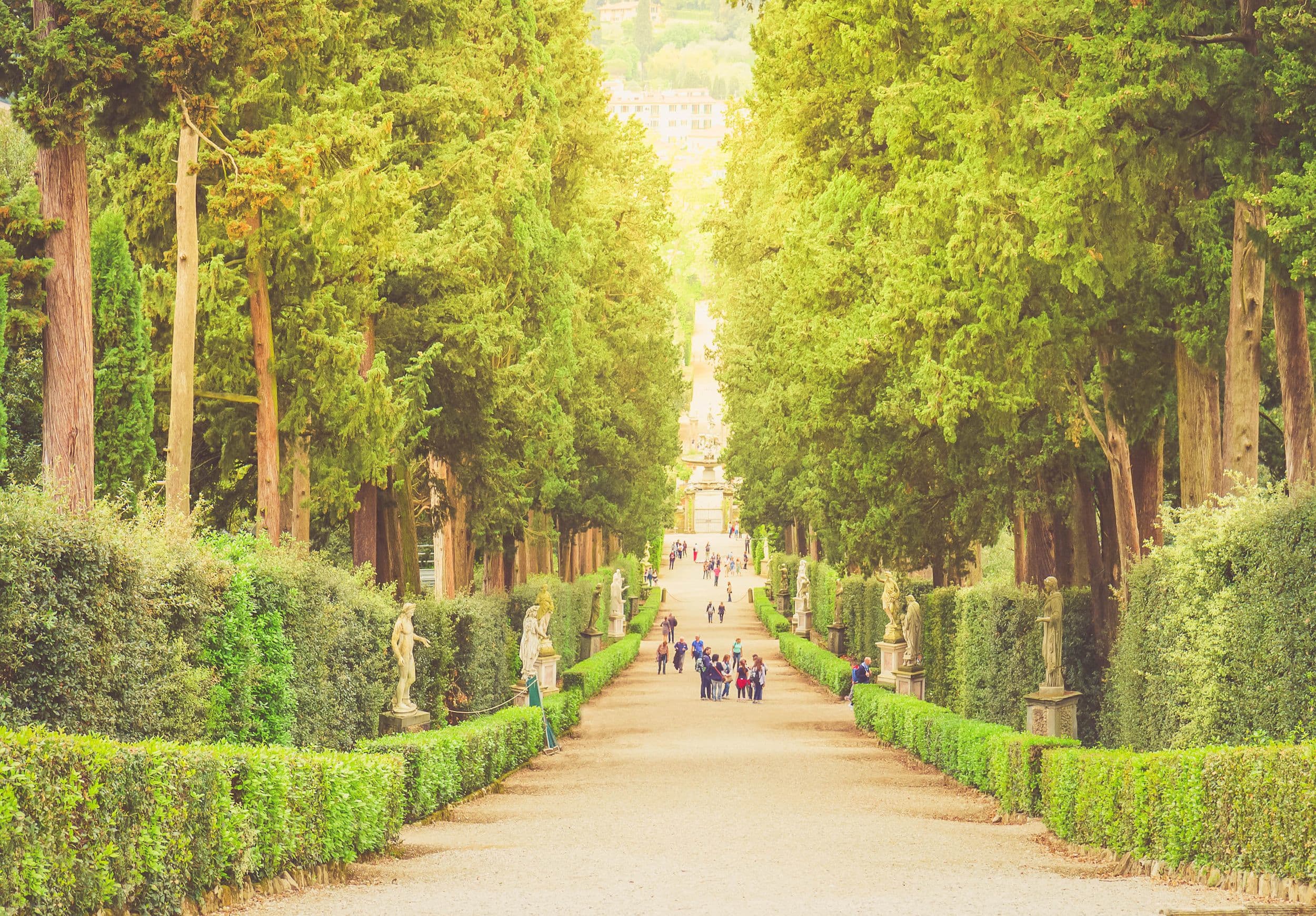
Boboli Gardens
 Highlight of Palazzo Pitti
Highlight of Palazzo PittiJoin locals and tourists alike in a park which the Medici's poured their hearts (and money) into creating.
Directly behind the Pitti Palace are the marvellous Boboli Gardens, which were developed over hundreds of years and funded by the immense gold reserves of the Medici family. This green hidden oasis in the heart of Florence is often considered an open air museum, rich in history and art, and blessed with plenty of water features, hidden paths, and fascinating grottoes. For those with museum overload, it makes for the perfect retreat, as well as a precious refuge from the city’s heat during the summer months. The adjoining Forte di Belvedere is also worth the hike up to it, as it offers spectacular views of Florence and the surrounding Tuscan hills.

Palazzo Pitti
 Highlight of Palazzo Pitti
Highlight of Palazzo PittiDiscover some of the Florence's best but often overlooked museums in the former palace of the Grand Dukes of Tuscany.
You'll find the Pitti Palace just a few steps from the Ponte Vecchio. In 1457, wealthy banker Luca Pitti began building the palace, but by the time it was completed, the family fortunes had run dry. He was forced to sell it to their arch-rivals, the Medicis, and thus it became the official residence of the Grand Dukes of Tuscany. On the first floor you'll find the Palatine Gallery and the Royal Apartments, the two most popular museums in the palace. They contain a collection of 16th and 17th-century paintings (including works by Raphael), and 28 beautiful rooms with original furnishing. On the ground floor is the Treasury, displaying a vast collection of Medici household treasures, from table silverware to precious stone vases, rock crystals and precious jewelry. There is also a Gallery of Modern Art, Porcelain Museum, and a museum showcasing costumes and fashion from the last 300 years. You can get a combined ticket which includes all the museums housed within the palace.

Boboli Gardens
 Highlight of Palazzo Pitti
Highlight of Palazzo PittiJoin locals and tourists alike in a park which the Medici's poured their hearts (and money) into creating.
Directly behind the Pitti Palace are the marvellous Boboli Gardens, which were developed over hundreds of years and funded by the immense gold reserves of the Medici family. This green hidden oasis in the heart of Florence is often considered an open air museum, rich in history and art, and blessed with plenty of water features, hidden paths, and fascinating grottoes. For those with museum overload, it makes for the perfect retreat, as well as a precious refuge from the city’s heat during the summer months. The adjoining Forte di Belvedere is also worth the hike up to it, as it offers spectacular views of Florence and the surrounding Tuscan hills.

Palazzo Pitti
 Highlight of Palazzo Pitti
Highlight of Palazzo PittiDiscover some of the Florence's best but often overlooked museums in the former palace of the Grand Dukes of Tuscany.
You'll find the Pitti Palace just a few steps from the Ponte Vecchio. In 1457, wealthy banker Luca Pitti began building the palace, but by the time it was completed, the family fortunes had run dry. He was forced to sell it to their arch-rivals, the Medicis, and thus it became the official residence of the Grand Dukes of Tuscany. On the first floor you'll find the Palatine Gallery and the Royal Apartments, the two most popular museums in the palace. They contain a collection of 16th and 17th-century paintings (including works by Raphael), and 28 beautiful rooms with original furnishing. On the ground floor is the Treasury, displaying a vast collection of Medici household treasures, from table silverware to precious stone vases, rock crystals and precious jewelry. There is also a Gallery of Modern Art, Porcelain Museum, and a museum showcasing costumes and fashion from the last 300 years. You can get a combined ticket which includes all the museums housed within the palace.

Boboli Gardens
 Highlight of Palazzo Pitti
Highlight of Palazzo PittiJoin locals and tourists alike in a park which the Medici's poured their hearts (and money) into creating.
Directly behind the Pitti Palace are the marvellous Boboli Gardens, which were developed over hundreds of years and funded by the immense gold reserves of the Medici family. This green hidden oasis in the heart of Florence is often considered an open air museum, rich in history and art, and blessed with plenty of water features, hidden paths, and fascinating grottoes. For those with museum overload, it makes for the perfect retreat, as well as a precious refuge from the city’s heat during the summer months. The adjoining Forte di Belvedere is also worth the hike up to it, as it offers spectacular views of Florence and the surrounding Tuscan hills.
prev
next

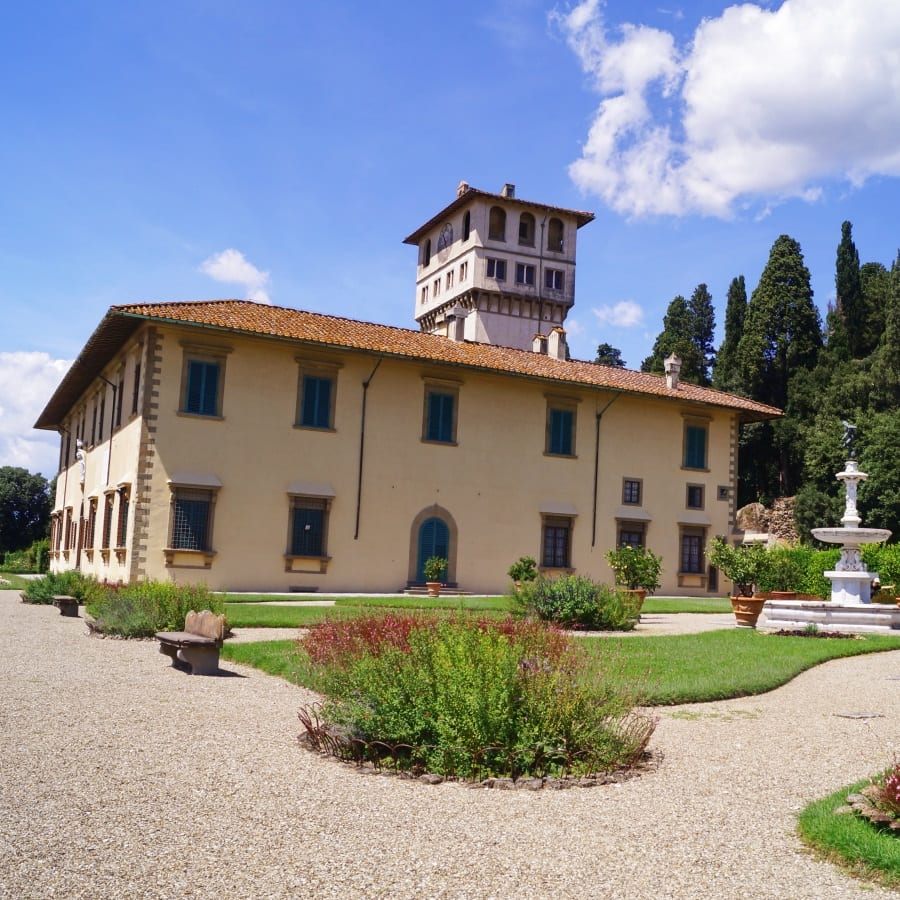
Day 9
Florence
View More
Day 9
Florence


Morning to Afternoon
Explore Renaissance Villas in the Nearby Hills of Florence
The Medicis and other powerful families of Renaissance Florence constructed magnificent country villas in the foothills surrounding the city and surrounded them with elaborate gardens populated with rose bushes, manicured hedgerows, and citrus trees. You can explore these beautiful villas which are concentrated in an area just a short bus ride from the city center of Florence. The villas served several functions, first and foremost as country palaces demonstrating power and wealth. They were also recreational resorts for the leisure and pleasure of their owners; and, more prosaically, they were the center of agricultural activities on the surrounding estates.

Villa di Castello
See the villa where Tuscany's first Grand Duke spent his childhood.
Show More

Villa La Petraia
Experience an amazing view of Florence as you stroll the gardens of this Medici family villa.
Show More

Villa di Castello
See the villa where Tuscany's first Grand Duke spent his childhood.
Show More

Villa La Petraia
Experience an amazing view of Florence as you stroll the gardens of this Medici family villa.
Show More

Villa di Castello
See the villa where Tuscany's first Grand Duke spent his childhood.
Show More

Villa La Petraia
Experience an amazing view of Florence as you stroll the gardens of this Medici family villa.
Show More
prev
next

Day 9
Florence
View More


Villa di Castello
 Highlight of Country Villas
Highlight of Country VillasSee the villa where Tuscany's first Grand Duke spent his childhood.
Villa di Castello is a 15th century Medici villa mostly famous as the residence where Duke Cosimo I de’Medici spent his childhood. Cosimo, who was later called the Father of the Nation, was the first member of the Medici political dynasty. Not surprisingly, Villa di Castello was his favourite villa and as an adult he expanded it with an extensive garden second only to the Boboli Gardens that included footpaths, fountains and the world famous Animal Grotto. The Villa is not accessible to the public since it has been the home of the prestigious Crusca Academy since 1583, a school dedicated to the study of the Italian language. You can, however, visit the splendid gardens without paying.

Villa La Petraia
 Highlight of Country Villas
Highlight of Country VillasExperience an amazing view of Florence as you stroll the gardens of this Medici family villa.
This fortified hilltop mansion was purchased by the Medici in the 16th century and transformed into a princely residence by Cardinal Ferdinando. The villa is richly decorated in the interior and has a beautiful Italian garden that attracts visitors from all around the world. The courtyard that is decorated with frescoes by Cosimo Daddi is probably the most impressive part of the villa, while a series of rooms you can visit present a later style. Both the structured Italian garden and the villa are open to visitors and the admission is free, with guided visits.

Villa di Castello
 Highlight of Country Villas
Highlight of Country VillasSee the villa where Tuscany's first Grand Duke spent his childhood.
Villa di Castello is a 15th century Medici villa mostly famous as the residence where Duke Cosimo I de’Medici spent his childhood. Cosimo, who was later called the Father of the Nation, was the first member of the Medici political dynasty. Not surprisingly, Villa di Castello was his favourite villa and as an adult he expanded it with an extensive garden second only to the Boboli Gardens that included footpaths, fountains and the world famous Animal Grotto. The Villa is not accessible to the public since it has been the home of the prestigious Crusca Academy since 1583, a school dedicated to the study of the Italian language. You can, however, visit the splendid gardens without paying.

Villa La Petraia
 Highlight of Country Villas
Highlight of Country VillasExperience an amazing view of Florence as you stroll the gardens of this Medici family villa.
This fortified hilltop mansion was purchased by the Medici in the 16th century and transformed into a princely residence by Cardinal Ferdinando. The villa is richly decorated in the interior and has a beautiful Italian garden that attracts visitors from all around the world. The courtyard that is decorated with frescoes by Cosimo Daddi is probably the most impressive part of the villa, while a series of rooms you can visit present a later style. Both the structured Italian garden and the villa are open to visitors and the admission is free, with guided visits.

Villa di Castello
 Highlight of Country Villas
Highlight of Country VillasSee the villa where Tuscany's first Grand Duke spent his childhood.
Villa di Castello is a 15th century Medici villa mostly famous as the residence where Duke Cosimo I de’Medici spent his childhood. Cosimo, who was later called the Father of the Nation, was the first member of the Medici political dynasty. Not surprisingly, Villa di Castello was his favourite villa and as an adult he expanded it with an extensive garden second only to the Boboli Gardens that included footpaths, fountains and the world famous Animal Grotto. The Villa is not accessible to the public since it has been the home of the prestigious Crusca Academy since 1583, a school dedicated to the study of the Italian language. You can, however, visit the splendid gardens without paying.

Villa La Petraia
 Highlight of Country Villas
Highlight of Country VillasExperience an amazing view of Florence as you stroll the gardens of this Medici family villa.
This fortified hilltop mansion was purchased by the Medici in the 16th century and transformed into a princely residence by Cardinal Ferdinando. The villa is richly decorated in the interior and has a beautiful Italian garden that attracts visitors from all around the world. The courtyard that is decorated with frescoes by Cosimo Daddi is probably the most impressive part of the villa, while a series of rooms you can visit present a later style. Both the structured Italian garden and the villa are open to visitors and the admission is free, with guided visits.
prev
next

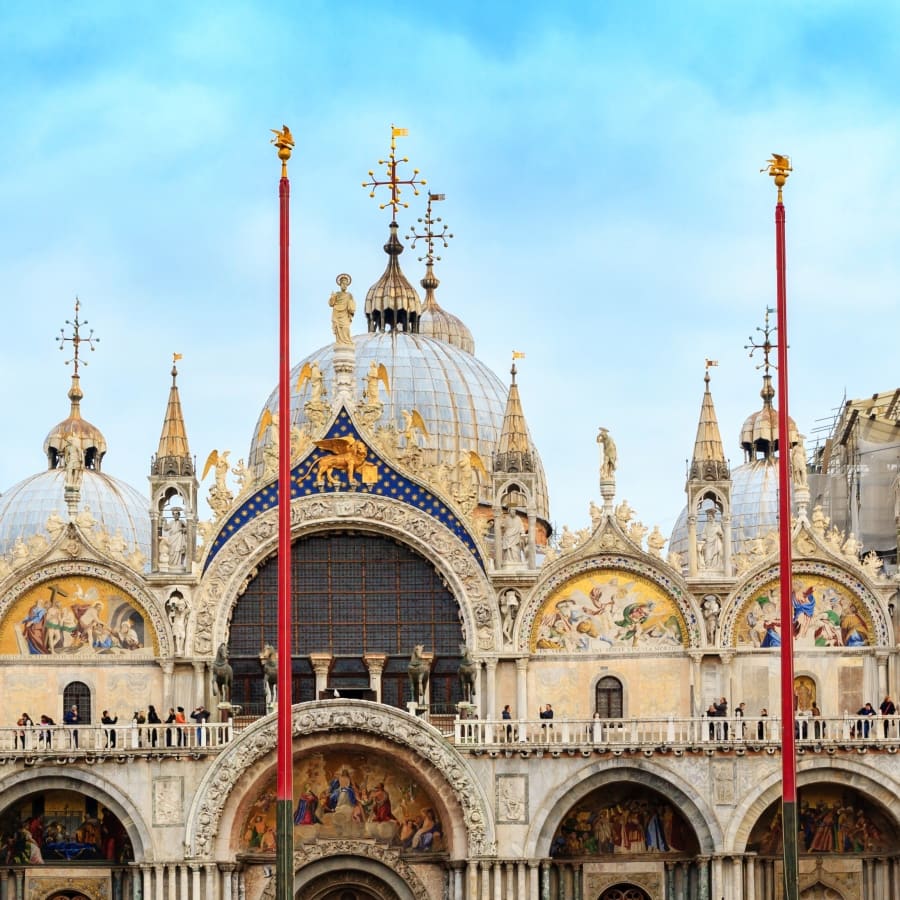
Day 10
Florence to Venice
View More
Day 10
Florence to Venice






9:20 AM
Transfer to Station by Taxi or Public Transport
Most trains depart from Firenza S.M.N. (i.e. Florence Santa Maria Novella Station) station, the largest station in the city. Before spending money on a transfer, be sure to check whether your hotel is within easy walking distance. Also consider that public transport is the cheapest and sometimes fastest option; trams and buses drop off next to the station. Uber is available in Florence, and if staying at a hotel, they can order a reliable taxi. Some private transfers will even help with your bags.

Day 10
Florence to Venice
View More



Day 11
Venice
View More
Day 11
Venice



Afternoon to Early Evening
St Mark's Square & Surroundings
St Mark's Square was the embodiment of The Most Serene Republic of Venice's power and prestige, and as such contains its most magnificent public buildings: the extraordinary golden mosaic-encrusted basilica of St Mark's, the exquisite Doge's Palace, the all-seeing bell tower, the Bibliotecca Marciana library, and what is nowadays the famous Correr Museum. If timed correctly, it is possible to see all these sights on your own within half a day, although a guide can make the process much more efficient (and more educational as well). Keep in mind that the square is one of the most heavily touristed places in the world, so crowds and lines can be an issue. St Mark the Evangelist was not the patrion saint of Venice until 829 AD, when two Venetian merchants stole St. Mark's remains from their original resting place in a chuch in Alexandria, Egypt, and then smuggled the relics home trussed up in a canvas sheet. The pretext for the theft was that the Muslim conquerors of Alexandria were expected to defile and plunder the church. While this may have been true, it is no coincidence that bringing such an important saint's relics to Venice was hugely important politically and signaled Venice's place as a rising independent power. A church was built to house the relics, and St. Mark's Square was established as the spiritual and political heart of the city.

Torre dell'Orologio
Check out a renaissance clock tower dating from 1499.
Show More

Correr Museum
Take a fascinating journey through the history and art of Venice inside one of its most important museums.
Show More

Library of St Mark
Visit the magnificent monumental rooms of the Marciana Library, one of the oldest public libraries in Venice.
Show More

St Mark's Square Campanile
Ascend this reconstructed cathedral bell tower for amazing views over St Marks Square, St Mark's Basilica and the Venetian lagoon.
Show More

St Marks Basilica
Step inside Venice's most sacred and famous landmark and admire the glittering mosaics of the basilica's domes.
Show More

Doges' Palace
Explore the staterooms and masterpieces inside this famous Gothic-style Palace.
Show More

Torre dell'Orologio
Check out a renaissance clock tower dating from 1499.
Show More

Correr Museum
Take a fascinating journey through the history and art of Venice inside one of its most important museums.
Show More

Library of St Mark
Visit the magnificent monumental rooms of the Marciana Library, one of the oldest public libraries in Venice.
Show More

St Mark's Square Campanile
Ascend this reconstructed cathedral bell tower for amazing views over St Marks Square, St Mark's Basilica and the Venetian lagoon.
Show More

St Marks Basilica
Step inside Venice's most sacred and famous landmark and admire the glittering mosaics of the basilica's domes.
Show More

Doges' Palace
Explore the staterooms and masterpieces inside this famous Gothic-style Palace.
Show More
prev
next

Day 11
Venice
View More

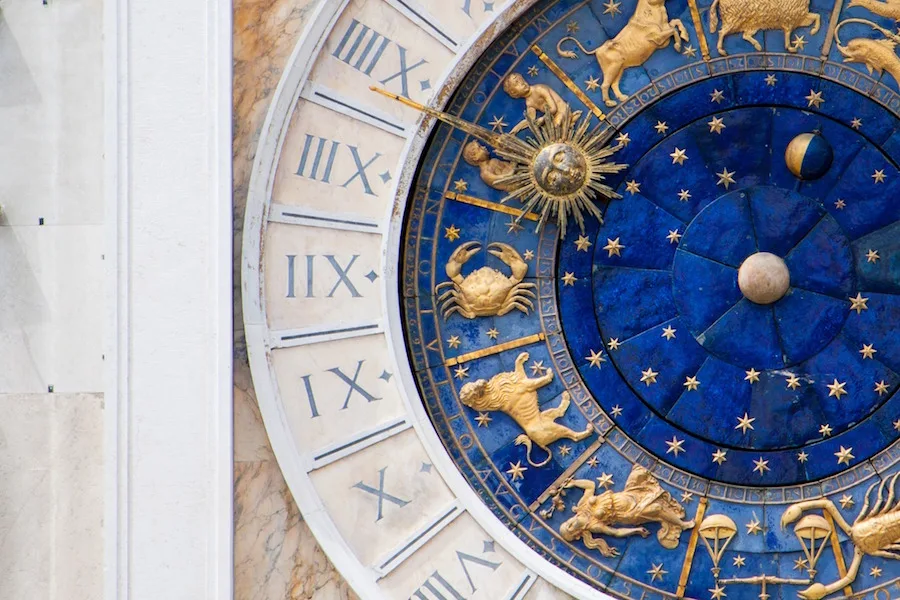
Torre dell'Orologio
 Highlight of St Mark's Square
Highlight of St Mark's SquareCheck out a renaissance clock tower dating from 1499.
St Mark's Clocktower or the Moors' Clocktower is one of the most famous historical landmarks in Venice. Originally built during the 15th century, the clocktower features an elaborate clock that displays the signs of the Zodiac and the current phase of the moon. It played an essential part of daily life in historical Venice, with seafarers setting out from the Grand Canal replying on its time to decide when to head out to sea. You'll notice at the top of the tower, two bronze wild men. They ring the bell on the hour. One of the men is old, the other is young, representing the passing of time.

Correr Museum
 Highlight of St Mark's Square
Highlight of St Mark's SquareTake a fascinating journey through the history and art of Venice inside one of its most important museums.
Established in 1830, 33 years after Venice lost its independence, the Museo Correr depicts life and culture in Venice during its glory days of wealth and strength. Somewhat ironically given that the museum is dedicated to Venice's glory, the city's loss of independence made the collection possible, as many formerly wealthy Venetian families were forced to sell their treasures in the difficult conditions. Highlights in the museum include works by the famed Neoclassical sculptor Antonio Canova and a fine art collection that covers the work of many famous Venetian painters of the 13th to 16th centuries. Also fascinating are the collected antiquities from the city's long history, such as ship flags, nautical instruments, books, maps, and coins.

Library of St Mark
 Highlight of St Mark's Square
Highlight of St Mark's SquareVisit the magnificent monumental rooms of the Marciana Library, one of the oldest public libraries in Venice.
The Sansoviniana library, also referred to as National Marciana Library, is one of the biggest and most important libraries in Italy. Located in a beautiful Renaissance building opposite the Doge's Palace, it holds a number of valuable Greek and Latin manuscripts. The interior is richly decorated, with an impressive ceiling and a collection of Venetian paintings including works by Tintoretto and Veronese.
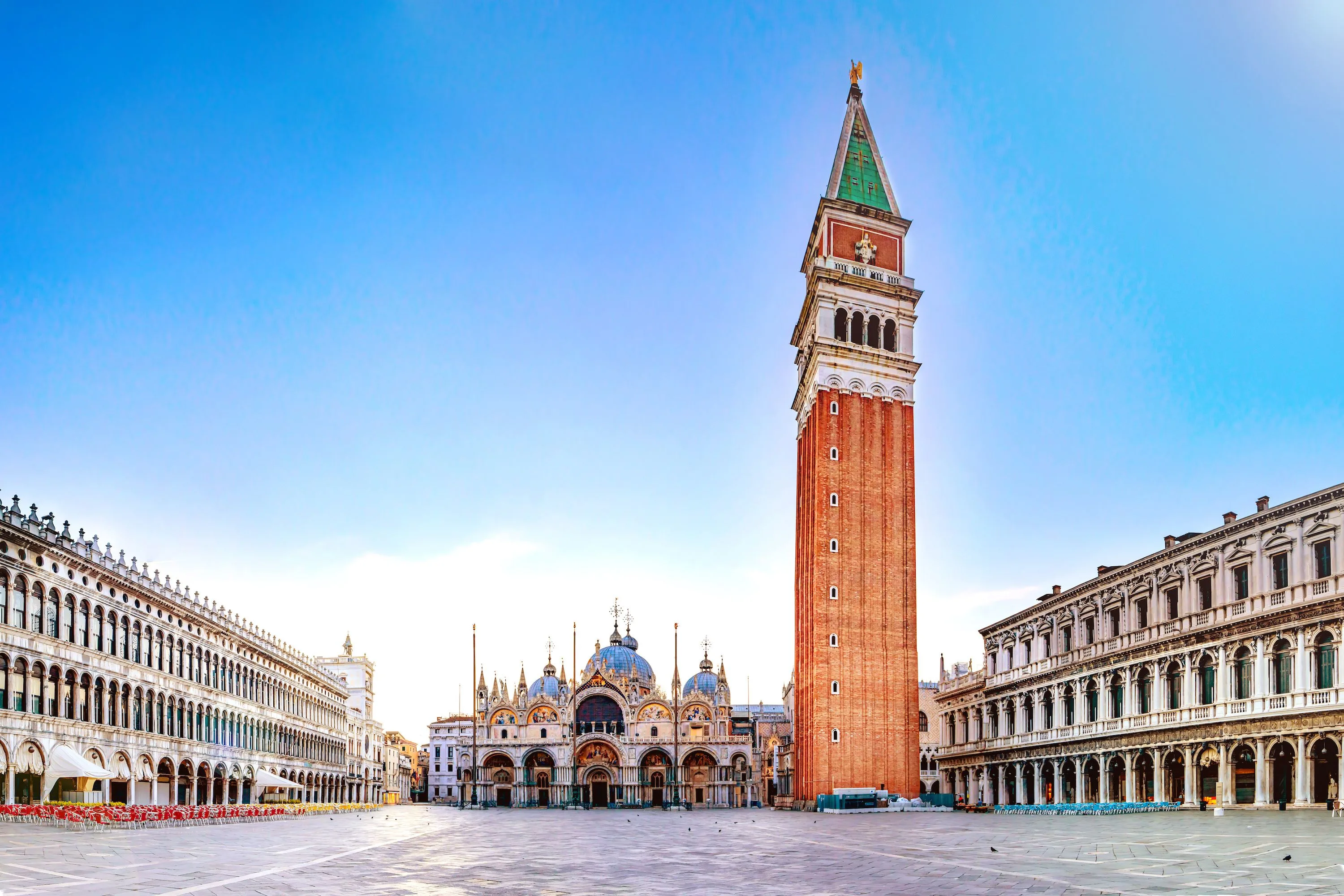
St Mark's Square Campanile
 Highlight of St Mark's Square
Highlight of St Mark's SquareAscend this reconstructed cathedral bell tower for amazing views over St Marks Square, St Mark's Basilica and the Venetian lagoon.
Standing at 325 feet (99m) high, the Campanile, i.e. bell tower, of St. Mark's Basilica dominates the city's iconic square. Crowned by a spire that once acted as a lighthouse for Venice's naval ships, the cathedral tower was first built in the 10th century AD but underwent repeated repairs, reconstructions, and additions until reaching its current form in the 16th century. It was also a prominent part of the Venetian penal system as criminals were sometimes subjected to the Supplizio della Cheba (Torture of the Cage), which involved being incarcerated inside a crate that was hoisted up the south side of the tower to be left dangling there for several days or more in all weather. The tower collapsed in 1902, and what you see today is actually an exact replica (with the convenient addition of an elevator). The bell tower is now one of the most visited sights in Venice, offering some incredible panoramic views over the city and its canals. Lines are long, but a ticket can be reserved in advance for an extra few Euros.
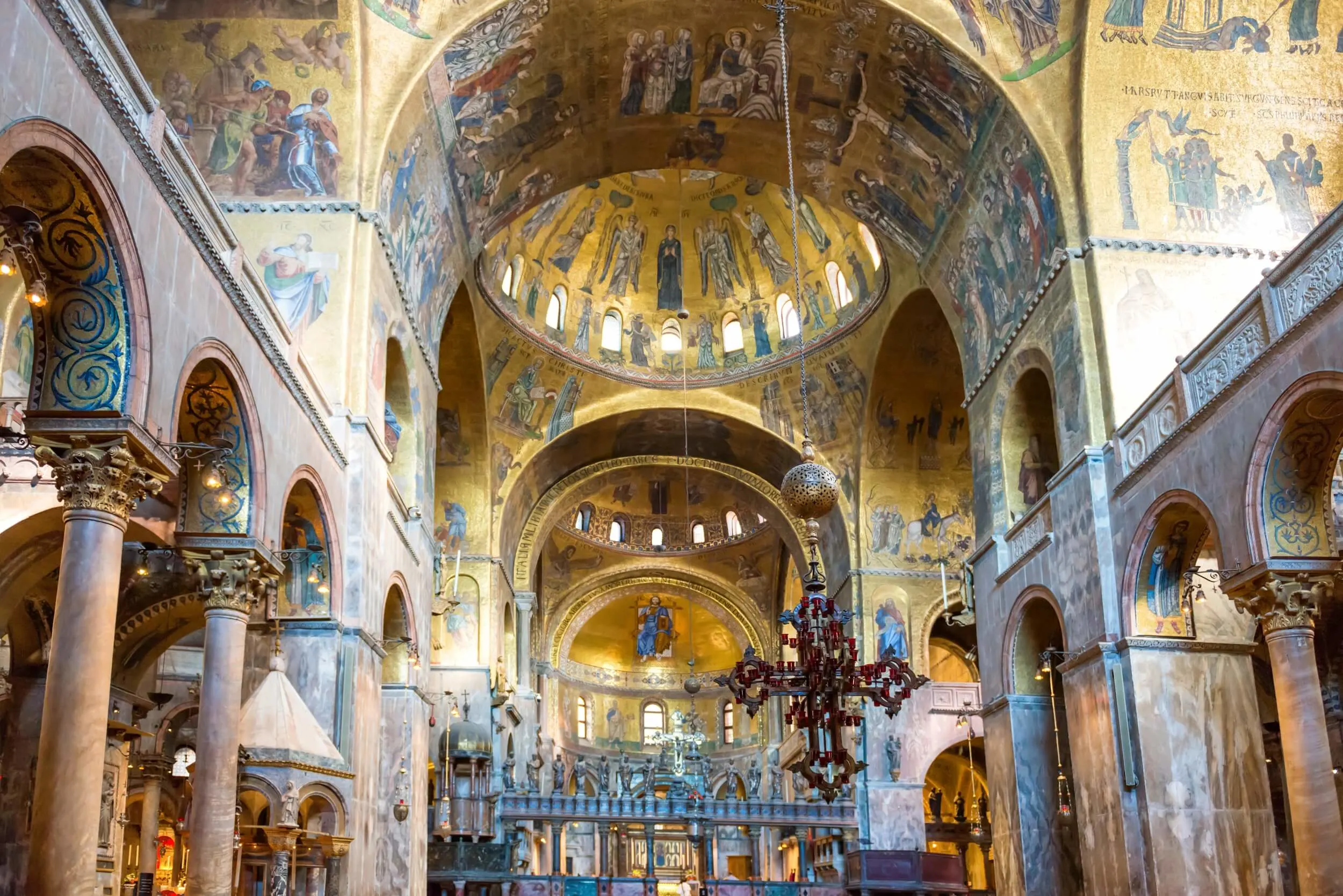
St Marks Basilica
 Highlight of St Mark's Square
Highlight of St Mark's SquareStep inside Venice's most sacred and famous landmark and admire the glittering mosaics of the basilica's domes.
Important Note: Entry to the basilica itself is free, but there are huge crowds queuing up outside to see the interior at almost any time of year (waiting times are on average 45min), so we very strongly advise you to purchase a 'skip the line' ticket A private chapel for the use of the Doges, the rulers of Venice, was purpose-built on the site and consecrated in 832 to house the stolen relics of St Mark. Destroyed in a fire, a replica was soon built, but this was in turn superseded by a third structure in 1063-94; the Basilica of St Mark. Today, it is one of the most iconic landmarks in Venice and a sight to behold for all visitors. The glittering mosaics, the golden altar behind St Mark's sarcophagus, its beautiful chapels, and treasury make it a sight you absolutely can not afford to miss. The stunning golden mosaics lining the interior were begun in the 12th century and work continued on them over the intervening centuries, but much of the exterior and interior decoration is actually art and monuments looted from cities defeated by Venice in its many wars. Many trophies seem out of place in a church, such as the Four Horses of San Marco, which were taken from Constantinople where they had once stood in the Hippodrome (the chariot racing arena). But the Venetians felt that anything which glorified Venice also reflected the glory and intercession of their patron saint, and thus belonged in the Basilica.
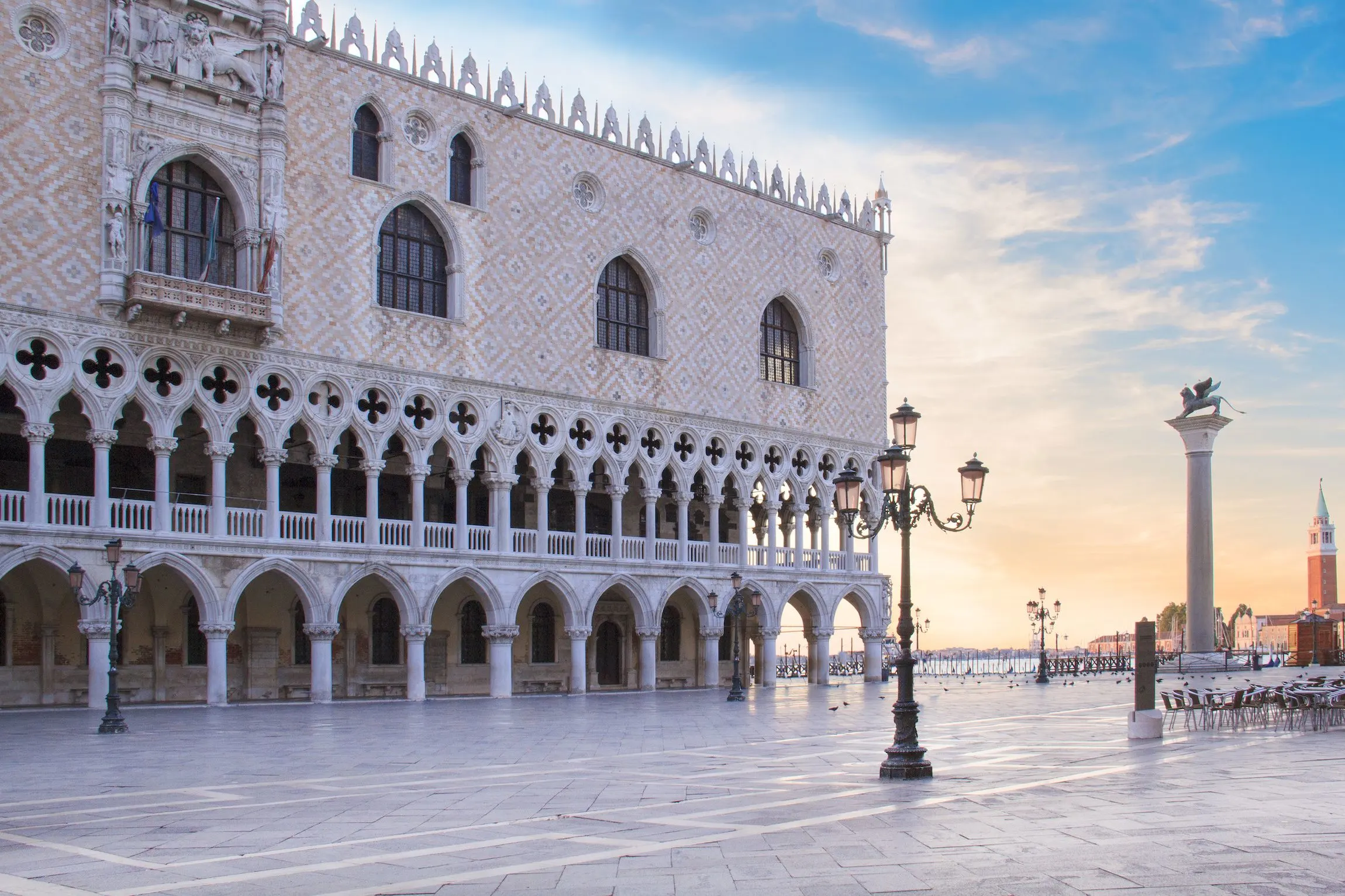
Doges' Palace
 Highlight of St Mark's Square
Highlight of St Mark's SquareExplore the staterooms and masterpieces inside this famous Gothic-style Palace.
Important Note: Entry lines can be very long. We suggest taking advantage of skip the line entry. As the name suggests, the Palace was the official residence of the Venetian rulers, the Doges, and the chief magistrates. The building was founded in the 9th century, but the present one dates from the 14th century. Tour its elaborate staterooms, grand halls and the 24-carat golden staircase before seeking out its collection of priceless masterpieces by Venetian artists including Titan, Veronese and Tintoretto. Be sure to spend some time in the most incredible room of all, the Chamber of the Great Council, the assembly hall where all Venetian patricians gathered to participate in the running of the city - up to 2,500 at any one time. There you will find the Doge's throne and the world's longest canvas painting in the world, Tintoretto's Il Paradiso.

Torre dell'Orologio
 Highlight of St Mark's Square
Highlight of St Mark's SquareCheck out a renaissance clock tower dating from 1499.
St Mark's Clocktower or the Moors' Clocktower is one of the most famous historical landmarks in Venice. Originally built during the 15th century, the clocktower features an elaborate clock that displays the signs of the Zodiac and the current phase of the moon. It played an essential part of daily life in historical Venice, with seafarers setting out from the Grand Canal replying on its time to decide when to head out to sea. You'll notice at the top of the tower, two bronze wild men. They ring the bell on the hour. One of the men is old, the other is young, representing the passing of time.

Correr Museum
 Highlight of St Mark's Square
Highlight of St Mark's SquareTake a fascinating journey through the history and art of Venice inside one of its most important museums.
Established in 1830, 33 years after Venice lost its independence, the Museo Correr depicts life and culture in Venice during its glory days of wealth and strength. Somewhat ironically given that the museum is dedicated to Venice's glory, the city's loss of independence made the collection possible, as many formerly wealthy Venetian families were forced to sell their treasures in the difficult conditions. Highlights in the museum include works by the famed Neoclassical sculptor Antonio Canova and a fine art collection that covers the work of many famous Venetian painters of the 13th to 16th centuries. Also fascinating are the collected antiquities from the city's long history, such as ship flags, nautical instruments, books, maps, and coins.

Library of St Mark
 Highlight of St Mark's Square
Highlight of St Mark's SquareVisit the magnificent monumental rooms of the Marciana Library, one of the oldest public libraries in Venice.
The Sansoviniana library, also referred to as National Marciana Library, is one of the biggest and most important libraries in Italy. Located in a beautiful Renaissance building opposite the Doge's Palace, it holds a number of valuable Greek and Latin manuscripts. The interior is richly decorated, with an impressive ceiling and a collection of Venetian paintings including works by Tintoretto and Veronese.

St Mark's Square Campanile
 Highlight of St Mark's Square
Highlight of St Mark's SquareAscend this reconstructed cathedral bell tower for amazing views over St Marks Square, St Mark's Basilica and the Venetian lagoon.
Standing at 325 feet (99m) high, the Campanile, i.e. bell tower, of St. Mark's Basilica dominates the city's iconic square. Crowned by a spire that once acted as a lighthouse for Venice's naval ships, the cathedral tower was first built in the 10th century AD but underwent repeated repairs, reconstructions, and additions until reaching its current form in the 16th century. It was also a prominent part of the Venetian penal system as criminals were sometimes subjected to the Supplizio della Cheba (Torture of the Cage), which involved being incarcerated inside a crate that was hoisted up the south side of the tower to be left dangling there for several days or more in all weather. The tower collapsed in 1902, and what you see today is actually an exact replica (with the convenient addition of an elevator). The bell tower is now one of the most visited sights in Venice, offering some incredible panoramic views over the city and its canals. Lines are long, but a ticket can be reserved in advance for an extra few Euros.

St Marks Basilica
 Highlight of St Mark's Square
Highlight of St Mark's SquareStep inside Venice's most sacred and famous landmark and admire the glittering mosaics of the basilica's domes.
Important Note: Entry to the basilica itself is free, but there are huge crowds queuing up outside to see the interior at almost any time of year (waiting times are on average 45min), so we very strongly advise you to purchase a 'skip the line' ticket A private chapel for the use of the Doges, the rulers of Venice, was purpose-built on the site and consecrated in 832 to house the stolen relics of St Mark. Destroyed in a fire, a replica was soon built, but this was in turn superseded by a third structure in 1063-94; the Basilica of St Mark. Today, it is one of the most iconic landmarks in Venice and a sight to behold for all visitors. The glittering mosaics, the golden altar behind St Mark's sarcophagus, its beautiful chapels, and treasury make it a sight you absolutely can not afford to miss. The stunning golden mosaics lining the interior were begun in the 12th century and work continued on them over the intervening centuries, but much of the exterior and interior decoration is actually art and monuments looted from cities defeated by Venice in its many wars. Many trophies seem out of place in a church, such as the Four Horses of San Marco, which were taken from Constantinople where they had once stood in the Hippodrome (the chariot racing arena). But the Venetians felt that anything which glorified Venice also reflected the glory and intercession of their patron saint, and thus belonged in the Basilica.

Doges' Palace
 Highlight of St Mark's Square
Highlight of St Mark's SquareExplore the staterooms and masterpieces inside this famous Gothic-style Palace.
Important Note: Entry lines can be very long. We suggest taking advantage of skip the line entry. As the name suggests, the Palace was the official residence of the Venetian rulers, the Doges, and the chief magistrates. The building was founded in the 9th century, but the present one dates from the 14th century. Tour its elaborate staterooms, grand halls and the 24-carat golden staircase before seeking out its collection of priceless masterpieces by Venetian artists including Titan, Veronese and Tintoretto. Be sure to spend some time in the most incredible room of all, the Chamber of the Great Council, the assembly hall where all Venetian patricians gathered to participate in the running of the city - up to 2,500 at any one time. There you will find the Doge's throne and the world's longest canvas painting in the world, Tintoretto's Il Paradiso.
prev
next


Day 12
Venice
View More
Day 12
Venice


Morning/Mid-Day
Rialto Bridge & San Polo District
The graceful arch of the Rialto Bridge is perhaps the single most iconic sight in Venice since nearly everyone passes beneath it on their journey along the Grand Canal. It connects Venice's two most visited districts, San Marco and San Polo. While San Marco is famous for St. Mark's Square, San Polo more than holds its own as a must-see destination, as it contains some of the city's oldest neighborhoods and most picturesque canals and bridges. It is also home to some of the best restaurants in Venice, and admittedly some of its worst tourist traps as well. Among many highlights is the bustling Rialto Market, which was once one of medieval Europe's busiest financial and trade markets, and still does a brisk trade in fresh seafood and produce.

Frari Church
Step inside this inconspicuous Gothic 15th-century church to discover some of Venice's most famous tombs and artwork.
Show More

Scuola Grande di San Rocco
Visit this underrated art museum featuring works by the famed Renaissance artist Tintoretto.
Show More

Rialto Bridge
Walk over or ride under the most famous bridge on the Grand Canal.
Show More

Rialto Markets
Experience the sights, tastes, and smells of Venice's historic "Pescaria" fish market, as well as the fresh produce market.
Show More

Frari Church
Step inside this inconspicuous Gothic 15th-century church to discover some of Venice's most famous tombs and artwork.
Show More

Scuola Grande di San Rocco
Visit this underrated art museum featuring works by the famed Renaissance artist Tintoretto.
Show More

Rialto Bridge
Walk over or ride under the most famous bridge on the Grand Canal.
Show More

Rialto Markets
Experience the sights, tastes, and smells of Venice's historic "Pescaria" fish market, as well as the fresh produce market.
Show More
prev
next

Day 12
Venice
View More

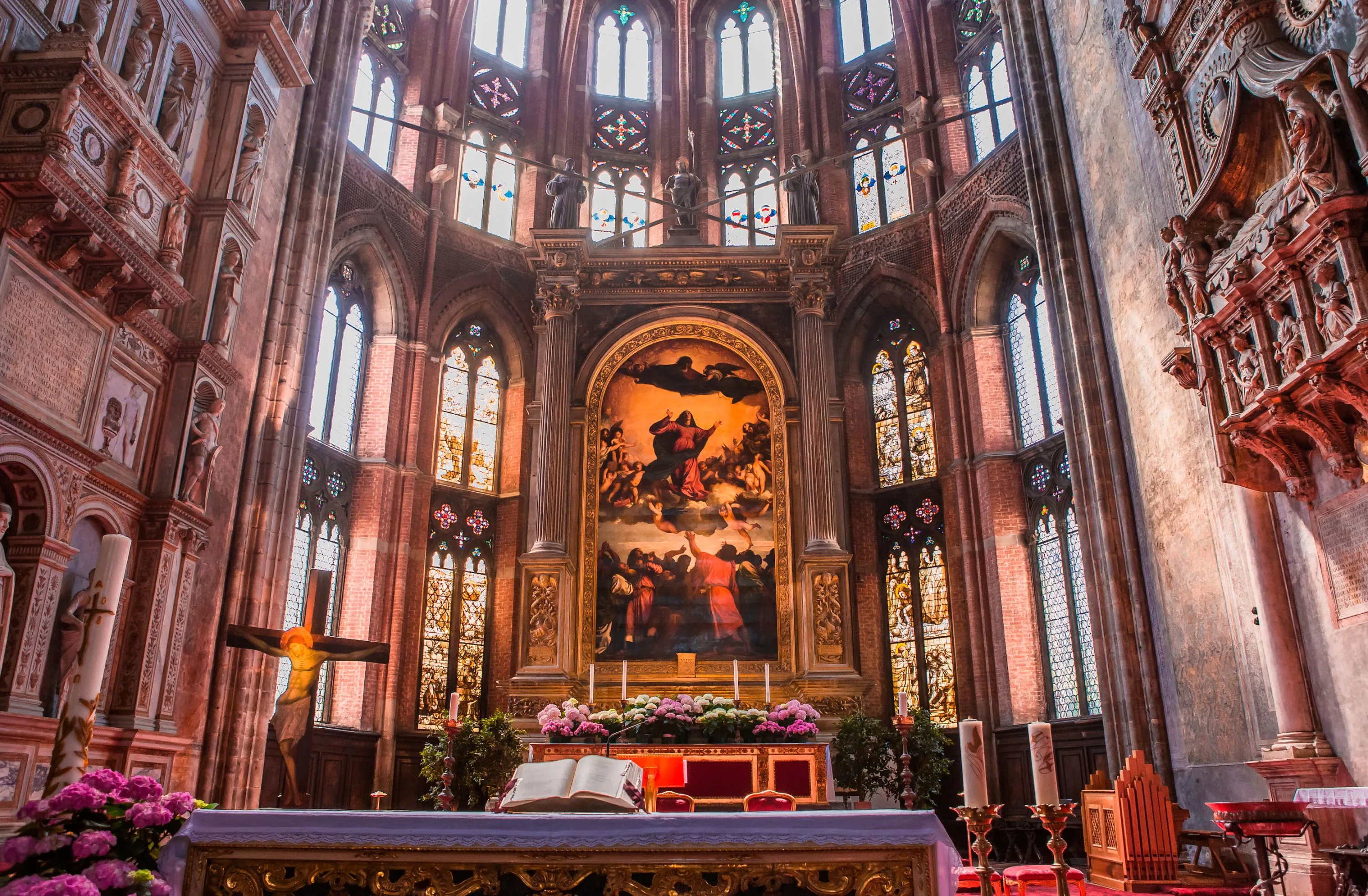
Frari Church
 Highlight of San Polo District
Highlight of San Polo DistrictStep inside this inconspicuous Gothic 15th-century church to discover some of Venice's most famous tombs and artwork.
The relatively austere brick Gothic Church of Santa Maria Gloriosa dei Frari holds many surprises. It has the second tallest campanile in Venice after St Mark's, and contains numerous masterpieces of painting and sculpture by the likes of Titian, Bellini and Donatello, plus a number of important doges' tombs, as well as Titian's tomb. Titian's majestic painting of The Assumption in the sanctuary, with its dramatic movement and coloring, is the work that established Titian's reputation as one of the greatest of all Italian painters. Even if you feel you've seen too many churches already, this one is definitely worth visiting and we recommend investing in the audio guide to get the best out of your time here.

Scuola Grande di San Rocco
 Highlight of San Polo District
Highlight of San Polo DistrictVisit this underrated art museum featuring works by the famed Renaissance artist Tintoretto.
Next door to the Frari, one of the most magnificent of Venice's charitable associations, The Scuola Grande di San Rocco is one of the most magnificent of Venice's charitable associations. The building was completed in 1560, and Tintoretto won a competition held to select an artist to decorate the interior. Over the next 23 years, he executed an incomparable series of paintings that cover the walls and ceilings. According to the writer Jan Morris, "no collection of sacred pictures is more overwhelming of impact than the immense series of Tintorettos in the Scuola [...] - often dark, often grandiose, often incomprehensible, but culminating in the huge masterpiece of the Crucifixion, which Velazquez humbly copied, and before which, to this day, you may still see strong men moved to tears."

Rialto Bridge
 Highlight of San Polo District
Highlight of San Polo DistrictWalk over or ride under the most famous bridge on the Grand Canal.
The 16th-century Rialto Bridge is the most iconic bridge in Venice. With a width of other 75 feet (23m) and span of over 100 feet (31m), the wide stone footbridge crosses over the Grand Canal and connects the San Marco and San Polo districts. It stands on the spot of an earlier wooden drawbridge which collapsed under the weight of a crowd gathered on it to watch a wedding procession. It took almost 150 years before the current Rialto bridge was built, this time in stone, and thus still stands as a symbol of the city. Surrounded by tourist shops and pricey restaurants, it sits on 12,000 wooden pilings and will be forever immortalised in millions of photographs as the backdrop to the classic Venetian photo shot, which captures the city's gondolas as they ferry lovers around the Grand Canal. While for many a gondola ride is a must-do experience in Venice, it's also possible to admire the bridge on foot. For a less-pricey way of seeing it from the water, you can always take the Number 1 local Vaporetto (water bus) and see the bridge as you pass underneath.
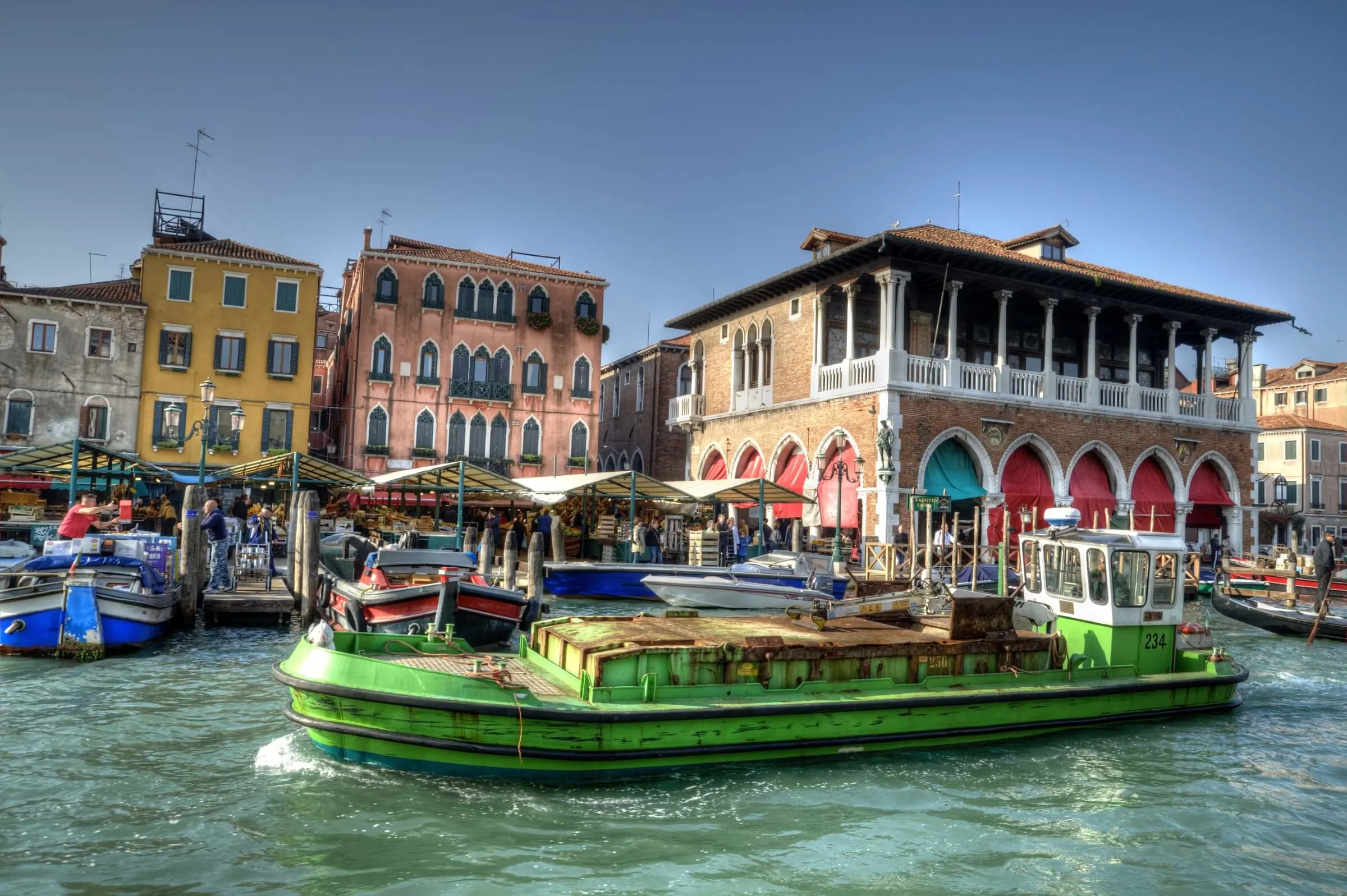
Rialto Markets
 Highlight of San Polo District
Highlight of San Polo DistrictExperience the sights, tastes, and smells of Venice's historic "Pescaria" fish market, as well as the fresh produce market.
Located close to the Rialto Bridge stands the Rialto Market, "the incomparable fish market of Venice, a glorious wet, colorful, high-smelling concourse of the sea, to which in the down hours fleets of barges bring the day's supply of sea-foods" (Jan Morris). Established well before the bridge was built, Venice's iconic market is a sight to behold, with colourful vegetable stalls and loud market vendors touting for business. It is a great spot for photographs and of course for a taste of the freshly caught fish with a host of appetising snacks on offer. Adjacent to the fish market you'll find a produce market, which is also important for a city which demands fresh ingredients for its cuisine. Keep in mind that the markets close at 1pm, and both markets are closed on Sundays (the fish market is also closed on Mondays).

Frari Church
 Highlight of San Polo District
Highlight of San Polo DistrictStep inside this inconspicuous Gothic 15th-century church to discover some of Venice's most famous tombs and artwork.
The relatively austere brick Gothic Church of Santa Maria Gloriosa dei Frari holds many surprises. It has the second tallest campanile in Venice after St Mark's, and contains numerous masterpieces of painting and sculpture by the likes of Titian, Bellini and Donatello, plus a number of important doges' tombs, as well as Titian's tomb. Titian's majestic painting of The Assumption in the sanctuary, with its dramatic movement and coloring, is the work that established Titian's reputation as one of the greatest of all Italian painters. Even if you feel you've seen too many churches already, this one is definitely worth visiting and we recommend investing in the audio guide to get the best out of your time here.

Scuola Grande di San Rocco
 Highlight of San Polo District
Highlight of San Polo DistrictVisit this underrated art museum featuring works by the famed Renaissance artist Tintoretto.
Next door to the Frari, one of the most magnificent of Venice's charitable associations, The Scuola Grande di San Rocco is one of the most magnificent of Venice's charitable associations. The building was completed in 1560, and Tintoretto won a competition held to select an artist to decorate the interior. Over the next 23 years, he executed an incomparable series of paintings that cover the walls and ceilings. According to the writer Jan Morris, "no collection of sacred pictures is more overwhelming of impact than the immense series of Tintorettos in the Scuola [...] - often dark, often grandiose, often incomprehensible, but culminating in the huge masterpiece of the Crucifixion, which Velazquez humbly copied, and before which, to this day, you may still see strong men moved to tears."

Rialto Bridge
 Highlight of San Polo District
Highlight of San Polo DistrictWalk over or ride under the most famous bridge on the Grand Canal.
The 16th-century Rialto Bridge is the most iconic bridge in Venice. With a width of other 75 feet (23m) and span of over 100 feet (31m), the wide stone footbridge crosses over the Grand Canal and connects the San Marco and San Polo districts. It stands on the spot of an earlier wooden drawbridge which collapsed under the weight of a crowd gathered on it to watch a wedding procession. It took almost 150 years before the current Rialto bridge was built, this time in stone, and thus still stands as a symbol of the city. Surrounded by tourist shops and pricey restaurants, it sits on 12,000 wooden pilings and will be forever immortalised in millions of photographs as the backdrop to the classic Venetian photo shot, which captures the city's gondolas as they ferry lovers around the Grand Canal. While for many a gondola ride is a must-do experience in Venice, it's also possible to admire the bridge on foot. For a less-pricey way of seeing it from the water, you can always take the Number 1 local Vaporetto (water bus) and see the bridge as you pass underneath.

Rialto Markets
 Highlight of San Polo District
Highlight of San Polo DistrictExperience the sights, tastes, and smells of Venice's historic "Pescaria" fish market, as well as the fresh produce market.
Located close to the Rialto Bridge stands the Rialto Market, "the incomparable fish market of Venice, a glorious wet, colorful, high-smelling concourse of the sea, to which in the down hours fleets of barges bring the day's supply of sea-foods" (Jan Morris). Established well before the bridge was built, Venice's iconic market is a sight to behold, with colourful vegetable stalls and loud market vendors touting for business. It is a great spot for photographs and of course for a taste of the freshly caught fish with a host of appetising snacks on offer. Adjacent to the fish market you'll find a produce market, which is also important for a city which demands fresh ingredients for its cuisine. Keep in mind that the markets close at 1pm, and both markets are closed on Sundays (the fish market is also closed on Mondays).
prev
next

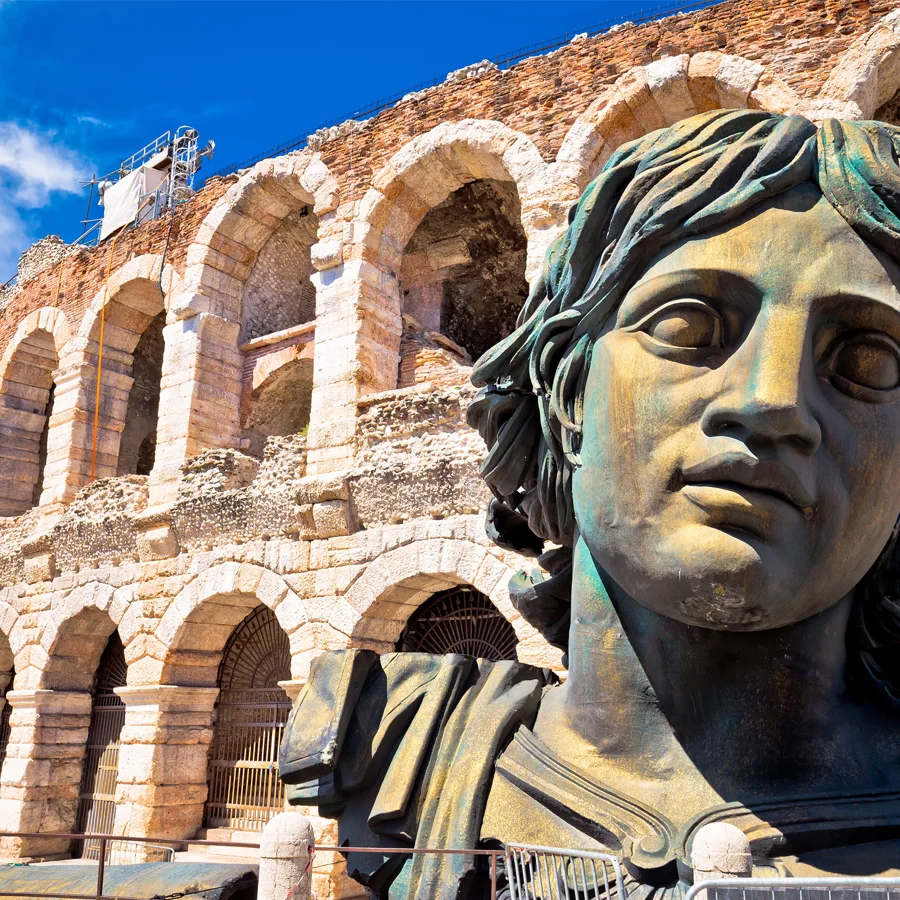
Day 13
Venice
View More
Day 13
Venice

Morning to Early Evening
Trip to Verona
Fair Verona, located just to the east of Lake Garda, is renowned for its beauty, its numerous buildings of immense artistic and historic value, and, of course, for its legendary story of Romeo and Juliet. There is more to Verona than just the Shakespearean tale, however. It is also home to one of the best preserved first-century amphitheaters in the world, as well as to a bustling historical center full of markets, boutique shops, and some fantastic eateries in which a stop for a taste of the regional wine is a must. Verona is an easy trip, as the fastest trains reach Verona in less than 75 minutes, and the historical heart of the city is only 1.2 miles (2 km) from the train station. There is a bus that connects the station to the central square, Piazza Brà. Verona's Old Town is surrounded by the River Adige on three sides, and many of its key attractions are located within a tightly-bound area of pedestrian-only streets. This makes exploring the city on foot very easy, which is a good thing since there is no public transport in the historical center.

Piazza dei Signori
Be sure not to miss this oft-overlooked historic square surrounded by beautiful buildings.
Show More

Roman Arena
Stand in a first century Roman amphitheatre that is so well preserved that it hosts concerts even today.
Show More

Torre dei Lamberti & Piazza delle Erbe
Climb to the top of the 275 feet (84m) high medieval tower overlooking the heart of historic Verona.
Show More

Giardino Giusti
Take a break in one of Verona's most beautiful and historic gardens.
Show More

Casa di Giulietta
Visit the fictional setting of Shakespeare's tale of the star-crossed lovers Romeo and Juliet.
Show More

Piazza dei Signori
Be sure not to miss this oft-overlooked historic square surrounded by beautiful buildings.
Show More

Roman Arena
Stand in a first century Roman amphitheatre that is so well preserved that it hosts concerts even today.
Show More

Torre dei Lamberti & Piazza delle Erbe
Climb to the top of the 275 feet (84m) high medieval tower overlooking the heart of historic Verona.
Show More

Giardino Giusti
Take a break in one of Verona's most beautiful and historic gardens.
Show More

Casa di Giulietta
Visit the fictional setting of Shakespeare's tale of the star-crossed lovers Romeo and Juliet.
Show More

Piazza dei Signori
Be sure not to miss this oft-overlooked historic square surrounded by beautiful buildings.
Show More
prev
next

Day 13
Venice
View More

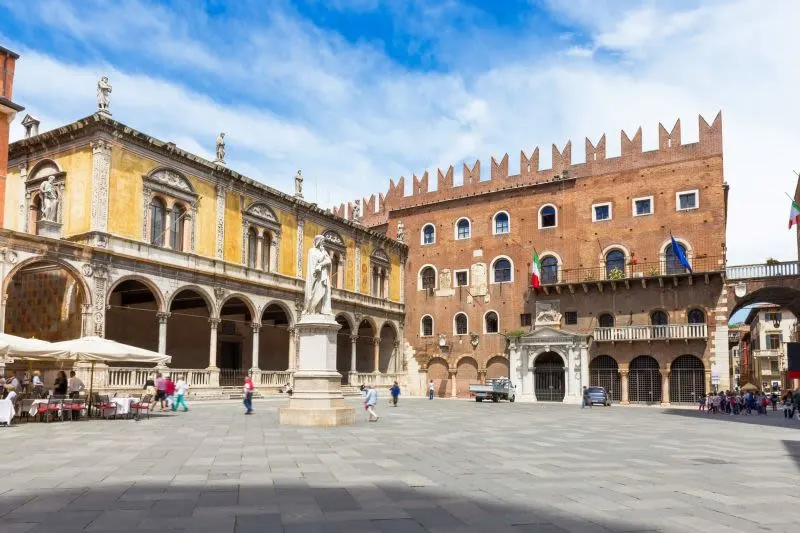
Piazza dei Signori
 Highlight of Verona
Highlight of VeronaBe sure not to miss this oft-overlooked historic square surrounded by beautiful buildings.
Lined by notable buildings and historic palaces, this public square is often overlooked by tourists. That is a shame as it is not only one of the most historic spaces in the city, but also one of the most elegant. Lining the square you'll see a number of buildings intricately tied to the city and its historic governance, such as the courthouse and the Scala Family Palace. In the center of the square you'll discover a monument of Dante, who spent seven years in Verona during his exile from Florence.

Roman Arena
 Highlight of Verona
Highlight of VeronaStand in a first century Roman amphitheatre that is so well preserved that it hosts concerts even today.
From gladiators to grand summer operas, this magnificent first-century Roman Arena, sitting in the heart of the city, has seen it all. In its heyday (circa 130-1100 AD), the arena could seat 30,000 spectators and was one of the biggest of its kind in the world. These days it hosts one of the most famous opera festivals in the world between June and September. While there’s little to see inside except the impressive stonework, it is quite an experience to visit a Roman arena that is still a thriving concert venue. Indeed, for many, the arena is more memorable than even the ruins of the Colosseum in Rome, simply because it is so intact. Indeed, when stepping inside the arena, you can truly feel as if you are experiencing the same venue that specators visited two thousand years ago. If you climb to the top, you’ll also enjoy great city views.

Torre dei Lamberti & Piazza delle Erbe
 Highlight of Verona
Highlight of VeronaClimb to the top of the 275 feet (84m) high medieval tower overlooking the heart of historic Verona.
The Torre dei Lamberti is Verona's tallest Medieval tower, built by the Lamberti family in 1172. The red-brick clock tower dominates the Piazza delle Erbe that sits below, and defines Verona's medieval skyline. As such it is a popular tourist attraction, with visitors heading to the top of the tower to admire the 360-degree panoramic views over the city and the 13th-century bells in the belfry. The Piazza delle Erbe, meanwhile, is one of the most beautiful squares in the city. What used to be a Roman forum and later a medieval marketplace, the square is now home to a number of cafes, souvenir stalls, and the Madonna Verona fountain, which dates back to the time of Roman rule.
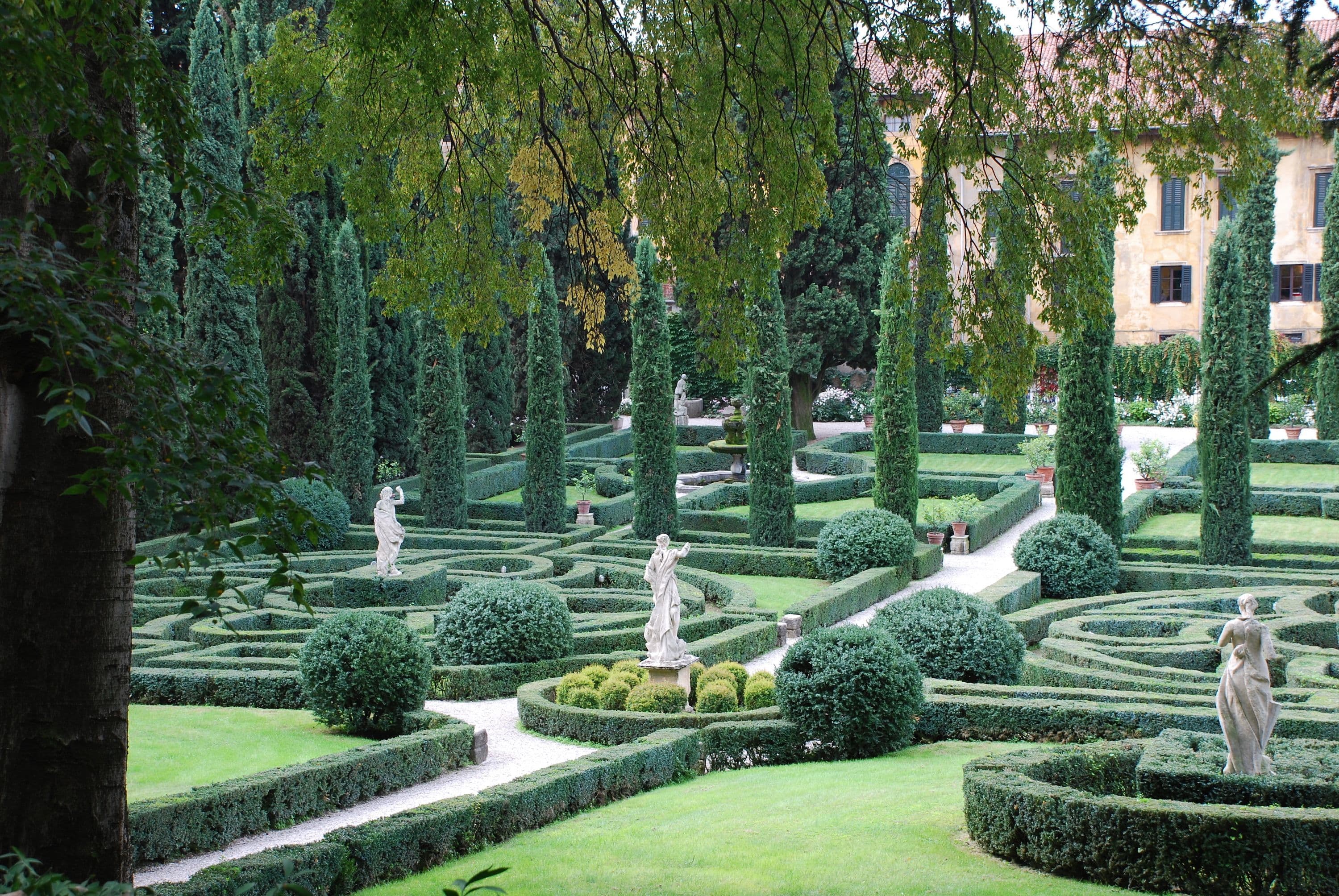
Giardino Giusti
 Highlight of Verona
Highlight of VeronaTake a break in one of Verona's most beautiful and historic gardens.
A litle ways from the center you'll discover an enchanting and relaxing retreat, the Giardino Giusti. These gardens are named after the Giusti family, which first used the property for wool dyeing in the 15th century. In the 16th century, the now quite wealthy family decided to use part of the property for more refined purposes, and a formal Renaissance garden was laid out, with maze-like short hedge rows, cypress trees, fountains, and grottoes.

Casa di Giulietta
 Highlight of Verona
Highlight of VeronaVisit the fictional setting of Shakespeare's tale of the star-crossed lovers Romeo and Juliet.
Shakespeare never set foot in Verona, yet his legendary tale lives on. The restored medieval building with its 1930s balcony opens into a courtyard of giggling teenagers and chattering tourists. Its bronze statue of Juliet is kept shiny by hundreds of thousands of hands who touch her right breast for good luck. Inside the house, period furniture and cinematic memorabilia are often overlooked by the hordes of tourists in line for the must-have "balcony" photograph.

Piazza dei Signori
 Highlight of Verona
Highlight of VeronaBe sure not to miss this oft-overlooked historic square surrounded by beautiful buildings.
Lined by notable buildings and historic palaces, this public square is often overlooked by tourists. That is a shame as it is not only one of the most historic spaces in the city, but also one of the most elegant. Lining the square you'll see a number of buildings intricately tied to the city and its historic governance, such as the courthouse and the Scala Family Palace. In the center of the square you'll discover a monument of Dante, who spent seven years in Verona during his exile from Florence.

Roman Arena
 Highlight of Verona
Highlight of VeronaStand in a first century Roman amphitheatre that is so well preserved that it hosts concerts even today.
From gladiators to grand summer operas, this magnificent first-century Roman Arena, sitting in the heart of the city, has seen it all. In its heyday (circa 130-1100 AD), the arena could seat 30,000 spectators and was one of the biggest of its kind in the world. These days it hosts one of the most famous opera festivals in the world between June and September. While there’s little to see inside except the impressive stonework, it is quite an experience to visit a Roman arena that is still a thriving concert venue. Indeed, for many, the arena is more memorable than even the ruins of the Colosseum in Rome, simply because it is so intact. Indeed, when stepping inside the arena, you can truly feel as if you are experiencing the same venue that specators visited two thousand years ago. If you climb to the top, you’ll also enjoy great city views.

Torre dei Lamberti & Piazza delle Erbe
 Highlight of Verona
Highlight of VeronaClimb to the top of the 275 feet (84m) high medieval tower overlooking the heart of historic Verona.
The Torre dei Lamberti is Verona's tallest Medieval tower, built by the Lamberti family in 1172. The red-brick clock tower dominates the Piazza delle Erbe that sits below, and defines Verona's medieval skyline. As such it is a popular tourist attraction, with visitors heading to the top of the tower to admire the 360-degree panoramic views over the city and the 13th-century bells in the belfry. The Piazza delle Erbe, meanwhile, is one of the most beautiful squares in the city. What used to be a Roman forum and later a medieval marketplace, the square is now home to a number of cafes, souvenir stalls, and the Madonna Verona fountain, which dates back to the time of Roman rule.

Giardino Giusti
 Highlight of Verona
Highlight of VeronaTake a break in one of Verona's most beautiful and historic gardens.
A litle ways from the center you'll discover an enchanting and relaxing retreat, the Giardino Giusti. These gardens are named after the Giusti family, which first used the property for wool dyeing in the 15th century. In the 16th century, the now quite wealthy family decided to use part of the property for more refined purposes, and a formal Renaissance garden was laid out, with maze-like short hedge rows, cypress trees, fountains, and grottoes.

Casa di Giulietta
 Highlight of Verona
Highlight of VeronaVisit the fictional setting of Shakespeare's tale of the star-crossed lovers Romeo and Juliet.
Shakespeare never set foot in Verona, yet his legendary tale lives on. The restored medieval building with its 1930s balcony opens into a courtyard of giggling teenagers and chattering tourists. Its bronze statue of Juliet is kept shiny by hundreds of thousands of hands who touch her right breast for good luck. Inside the house, period furniture and cinematic memorabilia are often overlooked by the hordes of tourists in line for the must-have "balcony" photograph.

Piazza dei Signori
 Highlight of Verona
Highlight of VeronaBe sure not to miss this oft-overlooked historic square surrounded by beautiful buildings.
Lined by notable buildings and historic palaces, this public square is often overlooked by tourists. That is a shame as it is not only one of the most historic spaces in the city, but also one of the most elegant. Lining the square you'll see a number of buildings intricately tied to the city and its historic governance, such as the courthouse and the Scala Family Palace. In the center of the square you'll discover a monument of Dante, who spent seven years in Verona during his exile from Florence.
prev
next


Day 14
Depart Venice
View More
Day 14
Depart Venice

To Be Determined
Transfer to Airport by Taxi or Water Bus
Most visitors will depart from the Venice Marco Polo Airport, which is located just across the water on the mainland. Because of the impossibility of driving inside Venice, you will need to take a water bus to Piazzale Roma on the edge of the city and then a land taxi to the airport (40 EUR), or take a water bus directly to the airport (15 EUR). It is also possible to take a private water taxi directly from your hotel to the airport, but it's very expensive. If you are departing from Venice Treviso Airport, you have much further to go. You can either take an expensive taxi ride (about 100 EUR) or take a shuttle bus for 12 EUR. The ATVO line departs from Piazzale Roma and takes 70 minutes, while the Barzi line picks up at the less convenient Tronchetto (the docks) but only takes 40 minutes.

Day 14
Depart Venice
View More


What's Included In Your Trip

Pre-Paid Tours and Activities:
- Grand Guided Walking Tour of the Historic Center
- Half Day Excursion to San Gimignano with a driver
- 'First Walk' Guided Tour in Venice
- Private Gondola Ride
- City Card for Rome, including discounts to many popular attractions

Pre-Paid Transportation:
- 2nd Class Train Tickets from Rome-Florence
- 2nd Class Train Tickets from Florence-Venice
- Public Transport Tickets for Venice and Rome
- Private Transfer from Rome Fiumicino to Hotel

Accommodation:
- 5 nights at a hotel of your choice in Rome
- 6 nights at a hotel of your choice in Florence
- 5 nights at a hotel of your choice in Venice

Go Real Travel Mobile App:
- Itinerary Plan & Reservations Info
- Points of Interest
- Detailed Travel Information
- Maps & Directions
Other Trips You May Like

12 Days
From$3175USD

10 Days
From$4600USD

12 Days
From$2999USD

15 Days
From$4266USD

7 Days
From$2139USD

10 Days
From$4033USD

8 Days
From$2424USD

12 Days
From$3129USD

10 Days
From$2600USD

12 Days
From$3175USD

10 Days
From$4600USD

12 Days
From$2999USD

15 Days
From$4266USD

7 Days
From$2139USD

10 Days
From$4033USD

8 Days
From$2424USD

12 Days
From$3129USD

10 Days
From$2600USD
prev
next
Featured Blogs
prev
next
Our Customers Say It Best
Otto Chuy, Los Angeles, California
I am still surprised how everything worked as planned, without a hitch. All instructions in your itinerary were precise and correct. Your suggestions and comments in each of the locations we went to were very helpful. All your guides, without exception, were wonderful and exactly on time. 

Kathy Mongeau, Ottawa, Ontario
My sister, Ann Ibberson, and I have been back home for a few weeks now and still go on and on about our fabulous trip. We were just blown away in every respect. Given the fact that we only had 1 ½ weeks, you had everything arranged for us so efficiently and your contacts who we dealt with for transfers, tours, hotels were extremely professional and personable. Things could not have gone better. 

Clive Andrew, Brisbane, Queensland
Just a quick note to let you know that I am back home now after probably the best overseas holiday that I have ever had, in no small part due to your very capable organization booking of hotels, tours, & trains. There was just nothing that went wrong with the timings etc. 

Malini Dutta, Boston, Massachusetts
We can't thank you enough for the detailed plans, maps, and suggestions. It really felt that someone was holding our hands and showing us around. We had all the excitement of discovering foreign lands, with none of the problems that can happen while negotiating unfamiliar places. In fact, all the cities felt like home within a few hours of arriving and exploring. 

Bev and Mark Frankel, Williamsburg, Virginia
We could not be more pleased with Go Real Travel! You took the guess work out of things like public transport but still managed to allow us the freedom to tour as we wanted. Our guides were exceptional and every time I saw a Viking Cruise tour of 25 people, I realized the quality experience we were getting with Go Real. 

Marianne Strydom, Paarl, South Africa
I just wanted to thank you for organizing an amazing trip for me – I packed in so much in such a short period of time and everything was just perfect. The way you do things makes it possible to really get to know the destination, which for me as a travel agent could not have been better. 

Otto Chuy, Los Angeles, California
I am still surprised how everything worked as planned, without a hitch. All instructions in your itinerary were precise and correct. Your suggestions and comments in each of the locations we went to were very helpful. All your guides, without exception, were wonderful and exactly on time. 

Kathy Mongeau, Ottawa, Ontario
My sister, Ann Ibberson, and I have been back home for a few weeks now and still go on and on about our fabulous trip. We were just blown away in every respect. Given the fact that we only had 1 ½ weeks, you had everything arranged for us so efficiently and your contacts who we dealt with for transfers, tours, hotels were extremely professional and personable. Things could not have gone better. 

Clive Andrew, Brisbane, Queensland
Just a quick note to let you know that I am back home now after probably the best overseas holiday that I have ever had, in no small part due to your very capable organization booking of hotels, tours, & trains. There was just nothing that went wrong with the timings etc. 

Malini Dutta, Boston, Massachusetts
We can't thank you enough for the detailed plans, maps, and suggestions. It really felt that someone was holding our hands and showing us around. We had all the excitement of discovering foreign lands, with none of the problems that can happen while negotiating unfamiliar places. In fact, all the cities felt like home within a few hours of arriving and exploring. 

Bev and Mark Frankel, Williamsburg, Virginia
We could not be more pleased with Go Real Travel! You took the guess work out of things like public transport but still managed to allow us the freedom to tour as we wanted. Our guides were exceptional and every time I saw a Viking Cruise tour of 25 people, I realized the quality experience we were getting with Go Real. 

Marianne Strydom, Paarl, South Africa
I just wanted to thank you for organizing an amazing trip for me – I packed in so much in such a short period of time and everything was just perfect. The way you do things makes it possible to really get to know the destination, which for me as a travel agent could not have been better. 



Explore cities in more detail

Milan
Milan is Italy’s most forward-looking city. An international center for fashion, fine dining, and design, it seems as though Milanese people breathe style. From the gleam on your wine glass to the twists of its cathedral’s spires, everything in Milan is finished to perfection. Home to the Italian stock exchange, a world-famous fashion industry, and a frantic business district, Milan is fast-paced and commercially minded. The shopping in Milan is second to none. At the Galleria Vittorio Emanuele II, one of the world’s oldest shopping malls, a glass-iron ceiling soars over brands like Louis Vuitton, Gucci, Massimo Dutti, and Amani. Along with the fashion, Milan’s cathedral, castle, and canals are also must-sees. But to view the city’s most prized possession - Leonardo da Vinci’s Last Supper, you must make an appointment. Tickets to view this mural sell out weeks in advance. It is truly a bucket-list worthy work of art. After a day taking in all the glamor and culture, take a seat in one of Milan’s well-appointed eateries. The Navigli Quarter is packed with restaurants, bars, and cafes, perfect for a relaxed Aperol spritz or pizza along the city’s canals.
Read More
Learn About Milan
Build Milan Trip

Cinque Terre
Cinque Terre, a string of five fishing villages in the Liguria region of Italy, is a rare snapshot of a traditional way of life. Rustic and charming, these clusters of pastel houses clinging to steep Mediterranean cliffs hold a special allure. Hiking between the five villages is a popular way to experience the rugged Mediterranean landscape close up. There are no roads here — the only other way to get between the villages is by boat or train. Seafood, hauled in from the azure waters of the sea that laps against the rocky shore, is abundant and delicious here. It pairs well with the local wine, and perhaps a plate of olives. Cinque Terre is a place to take it slow, to breathe in the fresh sea air and bask in the balmy climate, many miles from the chaos and frenzy of the modern world.
Read More
Learn About Cinque Terre
Build Cinque Terre Trip
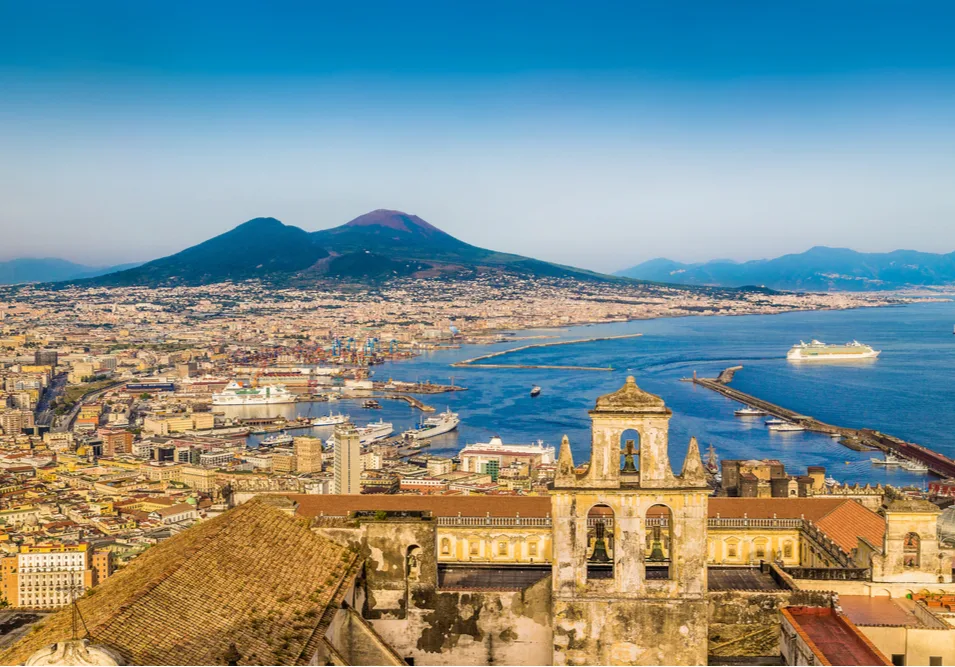
Naples
Gritty and chaotic Naples calls to travelers who want to experience the real Italy. Pressed along the coast of Campania, hilly Naples is jammed with maze-like streets, strung with outdoor clotheslines, descending toward the sea below. A much deserved UNESCO World Heritage site, Naples is famous for its churches, museums, castles, and catacombs. As you navigate the city, you’ll find yourself immersed by its culture and history. You can easily occupy a full day gazing at churches like the Naples Cathedral, San Francesco di Paola, and Cappella Sansevero. If you cast your eyes toward the Gulf of Naples, you’ll see Mount Vesuvius looming over the harbor. This foreboding volcano erupted in AD 79. Not far from the inner city — less than an hour by train — you’ll find the ancient town of Pompeii, its dramatic ruins still preserved in ash from the eruption. One of the best things you can do in Naples is to eat. This is the city where pizza was born. Propped up by its ripe tomatoes, local cheeses, and fresh fish, food from Naples has come to define what many see as the height of Italian cuisine. Everything you taste in Naples seems like a delicacy. Authentic and vivid, Naples is a true Italian city where the ancient world meets the modern-day with a bang.
Read More
Learn About Naples
Build Naples Trip

Rome
One of the must-sees of Italy, and indeed all of Europe, Rome is a city with history flowing through its veins. There is an endless amount to see, do, and learn here, with something for every taste and disposition. Rome was the center of Western civilization for a Millenium and during that time, accumulated a list of historical and cultural treasures that no other destination can truly match. The Pantheon, Colosseum, Roman Forum, and Cirus of Maxentius are just a few examples of what can be seen and experienced in Rome, which at times feels more like a giant outdoor museum than a city. At Rome’s heart, you’ll find the Vatican, home of the Roman Catholic Church and the Pope. Here visitors can see the legendary Sistine Chapel. Transcending a mere building, the chapel is a walk-in work of art. Although historical sights can be found on just about every corner, it’s entirely possible to fill a day just wandering around Rome. The city’s charming streets and open Piazzas are filled with beautiful sights and places to sit, grab the best Cappuccino in the world, and enjoy the view.
Read More
Learn About Rome
Build Rome Trip

Florence
Culture and history are thick in the air in Florence. Located on the banks of the Arno River in Tuscany, Florence’s past is deeply compelling. The birthplace of the Renaissance, Florence is where innovators like Dante, Machiavelli, Michelangelo, and Da Vinci made their fortunes. Centuries of art, politics, and commerce have left their mark on every stone in this Northern Italian city. In the 15th and 16th centuries, Florentine banks funded new enterprises that went on to change the history of the world. Powerful families like the Medici’s financed some of the finest art in history and pioneered new ways of doing statecraft and politics. As you stand in the Piazzale Michelangelo and gaze upon the city below it’s hard to take it all in at once. It feels like behind every door in Florence might hide a work of genius. Michelangelo’s David and Botticelli’s Primavera can be found just a short walk away. After a long day wandering the streets and gazing at art, fueled by exquisite coffee and gelato, relax like the locals do: with a glass of some of the best wine in the world.
Read More
Learn About Florence
Build Florence Trip
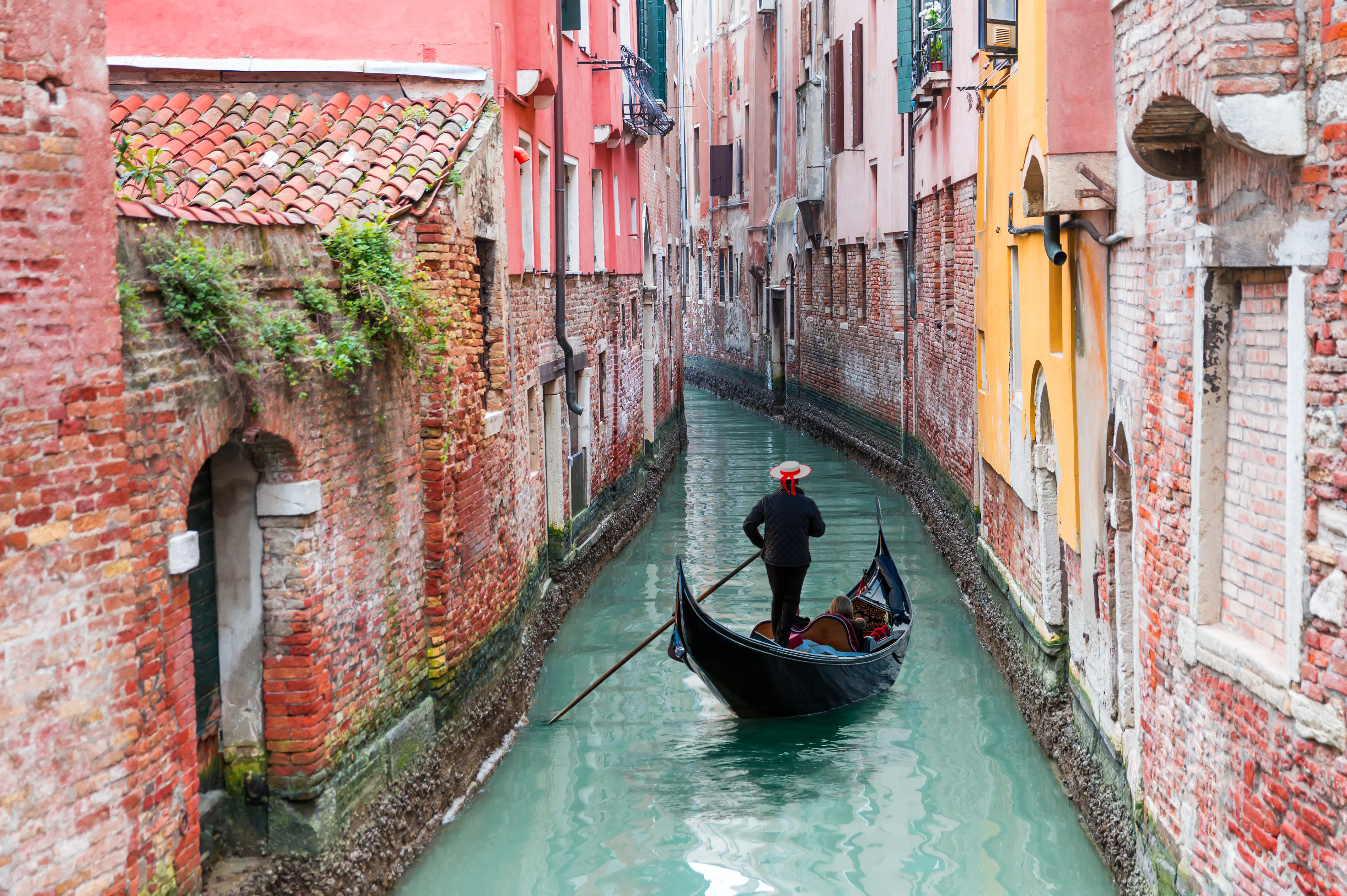
Venice
Venice is a city with no equal. Built on a series of islands on a lagoon, it was once a powerful city-state. Echoes of that old magnificence can be seen everywhere here, from the stunning buildings that rise out of the canals, to the bridges that arc across them. Take a Gondola ride through the canals that form the city’s veins, or wander through the winding streets drinking in the sights. You’ll see Venice attracts tourists in huge numbers, and that’s with good reason. It’s home to a seemingly limitless amount of art, culture, history, and architecture. St Mark’s Basilica, the Doge’s Palace, and the Campanile di San Marco just barely scratch the surface. There’s a 700-year-old market, Rialto, which is still open today. The Ponte di Rialto bridge connects the neighborhoods of San Marco and San Polo, stretching across the Grand Canal. Venice has weathered the last several centuries with elegance and pride, a place that will surpass even your highest expectations.
Read More
Learn About Venice
Build Venice Trip

Milan
Milan is Italy’s most forward-looking city. An international center for fashion, fine dining, and design, it seems as though Milanese people breathe style. From the gleam on your wine glass to the twists of its cathedral’s spires, everything in Milan is finished to perfection. Home to the Italian stock exchange, a world-famous fashion industry, and a frantic business district, Milan is fast-paced and commercially minded. The shopping in Milan is second to none. At the Galleria Vittorio Emanuele II, one of the world’s oldest shopping malls, a glass-iron ceiling soars over brands like Louis Vuitton, Gucci, Massimo Dutti, and Amani. Along with the fashion, Milan’s cathedral, castle, and canals are also must-sees. But to view the city’s most prized possession - Leonardo da Vinci’s Last Supper, you must make an appointment. Tickets to view this mural sell out weeks in advance. It is truly a bucket-list worthy work of art. After a day taking in all the glamor and culture, take a seat in one of Milan’s well-appointed eateries. The Navigli Quarter is packed with restaurants, bars, and cafes, perfect for a relaxed Aperol spritz or pizza along the city’s canals.
Read More
Learn About Milan
Build Milan Trip

Cinque Terre
Cinque Terre, a string of five fishing villages in the Liguria region of Italy, is a rare snapshot of a traditional way of life. Rustic and charming, these clusters of pastel houses clinging to steep Mediterranean cliffs hold a special allure. Hiking between the five villages is a popular way to experience the rugged Mediterranean landscape close up. There are no roads here — the only other way to get between the villages is by boat or train. Seafood, hauled in from the azure waters of the sea that laps against the rocky shore, is abundant and delicious here. It pairs well with the local wine, and perhaps a plate of olives. Cinque Terre is a place to take it slow, to breathe in the fresh sea air and bask in the balmy climate, many miles from the chaos and frenzy of the modern world.
Read More
Learn About Cinque Terre
Build Cinque Terre Trip

Naples
Gritty and chaotic Naples calls to travelers who want to experience the real Italy. Pressed along the coast of Campania, hilly Naples is jammed with maze-like streets, strung with outdoor clotheslines, descending toward the sea below. A much deserved UNESCO World Heritage site, Naples is famous for its churches, museums, castles, and catacombs. As you navigate the city, you’ll find yourself immersed by its culture and history. You can easily occupy a full day gazing at churches like the Naples Cathedral, San Francesco di Paola, and Cappella Sansevero. If you cast your eyes toward the Gulf of Naples, you’ll see Mount Vesuvius looming over the harbor. This foreboding volcano erupted in AD 79. Not far from the inner city — less than an hour by train — you’ll find the ancient town of Pompeii, its dramatic ruins still preserved in ash from the eruption. One of the best things you can do in Naples is to eat. This is the city where pizza was born. Propped up by its ripe tomatoes, local cheeses, and fresh fish, food from Naples has come to define what many see as the height of Italian cuisine. Everything you taste in Naples seems like a delicacy. Authentic and vivid, Naples is a true Italian city where the ancient world meets the modern-day with a bang.
Read More
Learn About Naples
Build Naples Trip

Rome
One of the must-sees of Italy, and indeed all of Europe, Rome is a city with history flowing through its veins. There is an endless amount to see, do, and learn here, with something for every taste and disposition. Rome was the center of Western civilization for a Millenium and during that time, accumulated a list of historical and cultural treasures that no other destination can truly match. The Pantheon, Colosseum, Roman Forum, and Cirus of Maxentius are just a few examples of what can be seen and experienced in Rome, which at times feels more like a giant outdoor museum than a city. At Rome’s heart, you’ll find the Vatican, home of the Roman Catholic Church and the Pope. Here visitors can see the legendary Sistine Chapel. Transcending a mere building, the chapel is a walk-in work of art. Although historical sights can be found on just about every corner, it’s entirely possible to fill a day just wandering around Rome. The city’s charming streets and open Piazzas are filled with beautiful sights and places to sit, grab the best Cappuccino in the world, and enjoy the view.
Read More
Learn About Rome
Build Rome Trip

Florence
Culture and history are thick in the air in Florence. Located on the banks of the Arno River in Tuscany, Florence’s past is deeply compelling. The birthplace of the Renaissance, Florence is where innovators like Dante, Machiavelli, Michelangelo, and Da Vinci made their fortunes. Centuries of art, politics, and commerce have left their mark on every stone in this Northern Italian city. In the 15th and 16th centuries, Florentine banks funded new enterprises that went on to change the history of the world. Powerful families like the Medici’s financed some of the finest art in history and pioneered new ways of doing statecraft and politics. As you stand in the Piazzale Michelangelo and gaze upon the city below it’s hard to take it all in at once. It feels like behind every door in Florence might hide a work of genius. Michelangelo’s David and Botticelli’s Primavera can be found just a short walk away. After a long day wandering the streets and gazing at art, fueled by exquisite coffee and gelato, relax like the locals do: with a glass of some of the best wine in the world.
Read More
Learn About Florence
Build Florence Trip

Venice
Venice is a city with no equal. Built on a series of islands on a lagoon, it was once a powerful city-state. Echoes of that old magnificence can be seen everywhere here, from the stunning buildings that rise out of the canals, to the bridges that arc across them. Take a Gondola ride through the canals that form the city’s veins, or wander through the winding streets drinking in the sights. You’ll see Venice attracts tourists in huge numbers, and that’s with good reason. It’s home to a seemingly limitless amount of art, culture, history, and architecture. St Mark’s Basilica, the Doge’s Palace, and the Campanile di San Marco just barely scratch the surface. There’s a 700-year-old market, Rialto, which is still open today. The Ponte di Rialto bridge connects the neighborhoods of San Marco and San Polo, stretching across the Grand Canal. Venice has weathered the last several centuries with elegance and pride, a place that will surpass even your highest expectations.
Read More
Learn About Venice
Build Venice Trip
prev
next


 Map of Your Itinerary Route
Map of Your Itinerary Route
Zoom In to the cities to see your itinerary in more detail


 4.8
4.8 








